
About UsThe Numismatic Bibliomania Society is a non-profit organization devoted to the study and enjoyment of numismatic literature. For more information please see our web site at coinbooks.org SubscriptionsThose wishing to become new E-Sylum subscribers (or wishing to Unsubscribe) can go to the following web page link MembershipThere is a membership application available on the web site Membership Application To join, print the application and return it with your check to the address printed on the application. Membership is only $20 to addresses in the U.S., $25 for First Class mail, and $30 elsewhere. For those without web access, write to: David M. Sundman, Treasurer
AsylumFor Asylum mailing address changes and other membership questions, contact David at this email address: dsundman@LittletonCoin.com SubmissionsTo submit items for publication in The E-Sylum, just Reply to this message, or write to the Editor at this address: whomren@gmail.com BUY THE BOOK BEFORE THE COIN |
- WAYNE'S WORDS: THE E-SYLUM DECEMBER 14, 2014
- LAKE BOOKS SALE #120 CLOSES DECEMBER 16, 2014
- KOLBE & FANNING OFFER RARE DUPRÉ PAMPHLETS
- BANK NOTE LITERATURE IN THE 2015 STACKS BOWERS NYINC SALE
- NEW BOOK: CIVIL WAR SUTLER TOKENS, 2ND EDITION
- NEW BOOK: LA COLECCIÓN CERVERA, MONEDA ANTIQUA DE HISPANIA
- BOOK REVIEW: CASH IN YOUR COINS, 2ND EDITION
- NEWMAN NUMISMATIC PORTAL LAUNCHES IN 2015
- THE HISTORY OF THE COIN LIBRARY
- NOTES FROM E-SYLUM READERS: DECEMBER 14, 2014
- QUERY: 1838-O HALF DOLLARS SOUGHT FOR RESEARCH
- 1795 MASSACHUSETTS STATE HOUSE TIME CAPSULE
- SOME RECENT AUCTION ITEMS: INDIAN PEACE AND PICASSO MEDALS
- EVERGLADES NATIONAL PARK QUARTER LAUNCH
- JOEL ISKOWITZ ON HIS FALLEN HEROES DESIGN
- U.S. MINT PROFILES MEDALLIC SCULPTOR JOSEPH MENNA
- HAYDEN ACQUIRES TANENBAUM GOOD-FOR TOKENS
- SOME INTERESTING TOKENS: DECEMBER 14, 2014
- EIGHTEENTH CENTURY LONDON MUSEUM TOKENS
- BILLIONAIRE BOUGHT WATSON’S GOLD NOBEL
- WAYNE'S NUMISMATIC DIARY: DECEMBER 14, 2014
- "HERCULES" COINS IN BURNHAM’S CELESTIAL HANDBOOK
- CHINESE CITY BURNS MONEY FOR POWER
- LORD ASHCROFT PAYS £312,000 FOR LATEST VICTORIA CROSS
- ARTICLE EXAMINES HIGH PRICES FOR MILITARY MEDALS
- ADAMS COLLECTION OF SPANISH COLONIAL PROCLAMATION MEDALS
- MARK LOVMO'S ARTICLES ON SOUTH KOREAN NUMISMATICS
- 'STUART LITTLE' PAINTING BRINGS $285,700
- HANUKKAH CHOCOLATE COINS
- COINS AT CHRISTMAS - A COIN COLLECTOR’S CHRISTMAS
- FEATURED WEB PAGE: U.S. MINT SPECIAL REPORT
Click here to access the complete archive
To comment or submit articles, reply to whomren@gmail.com
WAYNE'S WORDS: THE E-SYLUM DECEMBER 14, 2014

New subscribers this week include: Wolfgang Boehm of Kassel, Germany, courtesy of David Cassel; Scott Sery, and Bill Sponseller. Welcome aboard! We now have 1,797 subscribers.
This week we open with updates from literature dealers Fred Lake and David Fanning, some literature lots in the Stack's Bowers NYINC sale, two new books and one review. Next is information about the Newman Numismatic Portal, a new web site planned to debut in 2015.
Other topics include the 1838-O half dollar, the 1795 Massachusetts State House time capsule, the Everglades National Park quarter, U.S. Mint sculptor Joseph Menna, Steve Tanenbaum's Good-For tokens, Watson's gold Nobel prize medal, and South Korean numismatics.
To learn more about Augustin Dupré, Congreve’s Principals of Security Against Forgery, Civil War Sutler tokens, the Numismatic Indexes Project, Royal succession and the state mourning period, Sir Aston Lever's Holophusicon, Pablo Picasso's medals, Mount Vernon Shingle Script, Love Warts and Bicycle Face, read on. Have a great week, everyone!
Wayne Homren
Editor, The E-Sylum
LAKE BOOKS SALE #120 CLOSES DECEMBER 16, 2014
A reminder that Lake Books’ 120th mail-bid sale of numismatic literature sale closes on Tuesday, December 16, 2014 at 5:00 PM (EST). The sale may be viewed at http://www.lakebooks.com/current.html.
The sale features selections from the library of William S. Panitch and includes hard-to-find volumes such as Clain-Stefanelli’s bibliography that contains 1,848 pages of useful material, Newcomb’s work on early Large Cents, a nice 5th edition "Redbook", and a diverse group of reference works on tokens and medals, paper money, et al. Be sure to bid early as ties are won by the earliest bid received. You may bid via email, telephone or fax until the closing time.
Good Luck with your bidding. Cordially, Fred
Lake Books
6822 22nd Ave N
St. Petersburg, FL 33710-3918
727-343-8055 fax: 727-381-6822
KOLBE & FANNING OFFER RARE DUPRÉ PAMPHLETS
KOLBE & FANNING TO OFFER RARE PAMPHLETS BY AUGUSTIN DUPRÉ IN THEIR NEW YORK AUCTION
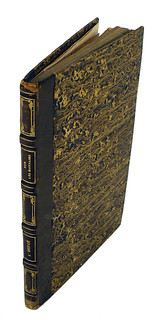 Among the highlights of Kolbe & Fanning’s January 10 New York Book Auction is an exceptional volume of pamphlets by Augustin Dupré regarding his
role in French coinage, from the library of the author. The volume, lot 112 in the sale, comprises five publications by Dupré, some of them annotated
in his own hand. The volume as a whole is inscribed by Narcisse Dupré, son of Augustin, and is in an early 19th-century binding.
Among the highlights of Kolbe & Fanning’s January 10 New York Book Auction is an exceptional volume of pamphlets by Augustin Dupré regarding his
role in French coinage, from the library of the author. The volume, lot 112 in the sale, comprises five publications by Dupré, some of them annotated
in his own hand. The volume as a whole is inscribed by Narcisse Dupré, son of Augustin, and is in an early 19th-century binding.
The five pamphlets are a remarkable source of information on Dupré’s efforts on behalf of the redesign of French coinage during and after the Revolution. Three of them consist of versions of his Observations présentées au comité des monnoies de l’assemblée nationale (1790), with the first two versions being annotated by Dupré in anticipation of the printing of the final edition. The volume also includes Dupré’s 1791 Réponse à l’écrit de M. Beyerlé ... dénonçant la fabrication des pièces de 15 sols and a 1792 publication written with Bertrand Verlac, Observations rélatives au Mémoire que la Commission générale des monnoyes...
Dupré (1748-1833), remains one of the most important engravers of French coins in modern history, and his designs for early U.S. medals (mostly notably the Libertas Americana) have ensured his lasting fame in the western hemisphere. An engraver by trade, Dupré began to work on medals in the early 1770s and quickly became adept. Notable works include several classic medals of the Comitia Americana series: those for Nathanael Greene, John Paul Jones and Daniel Morgan, as well as the related Diplomatic Medal and the Libertas Americana medal.

During the French Revolution, he became interested in applying his ideas to the new national coinage. Dupré wrote his October 1790 Observations addressed to the Comité des Monnoies de l’Assemblée Nationale. In early 1791, the Assembly adopted some of Dupré’s ideas and initiated a contest for new coin designs under the eye of painter Louis David. Dupré won the competition and became the 14th graveur général des monnaies on July 11, 1791. His neoclassical designs would win him fame and admiration that continue to this day.
Dupré’s rise to prominence in a period of political upheaval made him enemies, and he was seriously threatened during the Terror when he was denounced by one Beyerlé, who accused Dupré of producing inferior coinage. In Dupré’s Réponse, he not only defends himself, but insists on reforms he had proposed earlier. The final work present in the volume was written with Bertrand Verlac, an influential "homme de loi" and functionary with the Ministry of the Navy. It is a detailed response to a report to the Convention Nationale on the redesign of the coinage. Written at the height of the Revolution, it is an important statement of Dupré’s beliefs and artistic vision.

All five of these works are rare, being known primarily from institutional holdings and being virtually unknown on the secondary market. They were generally unheard of by modern numismatists until the April 2, 2014 sale of the Dupré archives by Bonhams in New York, of which this was part.
Kolbe & Fanning’s public auction will be held on Saturday, January 10, 2015 at the Waldorf-Astoria Hotel in New York City. The sale will be held in conjunction with the New York International Numismatic Convention. Printed catalogues have been mailed to established clients. A PDF of the catalogue has been posted to the Kolbe & Fanning website at www.numislit.com. Prospective bidders may also access the live online catalogue and register to bid through auction.numislit.com. Please contact David Fanning at df@numislit.com for more information.
Joel writes:
This archive provides an extraordinary opportunity to learn, at first-hand, the numismatic philosophy and coinage artistry of one of the seminal influencers of American numismatics, Augustin Dupré. One of Dupré's countrymen, Jacques Barzun, famously wrote, in God's Country and Mine, "Whoever wants to know the heart and mind of America had better learn baseball." I would say that whoever wants to know the heart and mind of early American coinage had better learn about Dupré.
BANK NOTE LITERATURE IN THE 2015 STACKS BOWERS NYINC SALE
Lot #2094: 1819 Report on Preventing the Forgery of Bank Notes
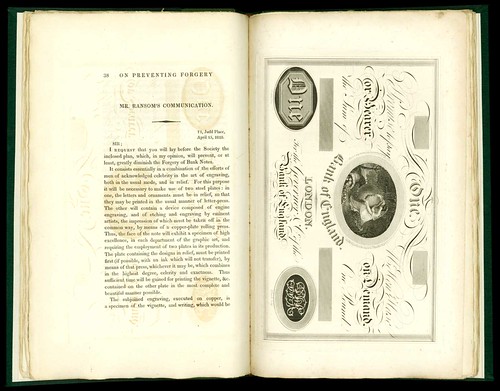
"Report of the Committee of the SOCIETY OF ARTS, c…….together with the approved communications, and evidence upon the same relative to the mode of Preventing the Forgery of BANK NOTES". London, 1819. Bound in Quarter Green Morocco Leather. Superb.
Very Rare Society of Arts 1819 "Preventing the Forgery of Bank Notes" A stellar and very rare volume, immaculate to behold and early: of great importance by textual content and engraved plates. Octavo. 17cm by 26cm. Finely bound in quarter green morocco leather with two raised bands by Sam Ellenport. Gilt edge titled "PREVENTING FORGERY OF BANK NOTES 1819". Complete, 72pp, plus three additional 57*, 58*, 59*. Six plates (one folding). Half title and full title page (named upper right).Printed by the order of the Society, with imprint T.C. Hansard, Printer. Etc... on title verso. Page 26, illustrated with Hansard’s Bank of England typographical protective micro-letter devices.
Plate I, opposite p32 : "T.C. Hansard’s Plan for a Typographic Bank Note". Printed on delicate paper with embossed central coat of arms. Plate II, opposite p38. Wide margin proof impression plate on card. Bank of England sample note, vignette of seated female center, various devices and text. Signed vignettes and imprint of Lambert, Newcastle-on-Tyne. Plate III, opposite p50. Vertical plate on card stock dated June 4, 1818 and titled. Central vignette of helmeted warrior (style of Heath, Perkins, Fairman) and enclosed in security lathe bands. Plate II, opposite p56. Folding plate of improved printing press. Plate V, opposite p58* intense lathe same for signature area of note by Richard Williamson (with interleave). Stunning. Plate VI, opposite p58* consecutive to last. Steel engraving on card for back of notes by Williamson. Cursive "ONE" center.
A fascinating work, complete and extremely rare and desirable thus. The interior condition is glorious, well printed and deeply embossed text pages. Plates choice overall with barest minimum of library soiling. All are now beautifully bound into a superbly crafted green morocco and complementary cloth volume. The first example we have enjoyed studying and cataloguing. Estimate: $1,500.00 - $2,500.00
To read the complete lot description, see:
"Report of the Committee of the
SOCIETY OF ARTS ..." (www.stacksbowers.com/BrowseAuctions/LotDetail/
tabid/227/AuctionID/6066/Lot/2094/Default.aspx)
Lot 2096: Congreve’s 1820 Principals of Security Against Forgery
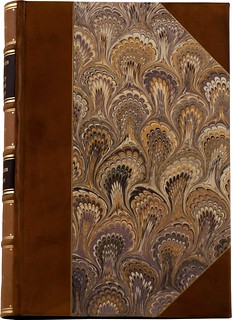 "An Analysis of The True Principals of Security Against Forgery; Exemplified By An Enquiry
Into the Sufficiency of the American Plan For a New Bank Note; with Imitations of Four of the Most Difficult Specimens of those Notes, Made By
Ordinary Means; By which it is proved that there is no adequate Security to be achieved in One Colour, in the present State of the Arts, and that the
True Basis of Security is in the Due Application of Relief Engraving, and Printing in Two or More Colours". Sir William Congreve, Bart. Second
Edition. London: 1820. Enclosed in Custom Three Quarter Morocco Solander Box. Very Fine.
"An Analysis of The True Principals of Security Against Forgery; Exemplified By An Enquiry
Into the Sufficiency of the American Plan For a New Bank Note; with Imitations of Four of the Most Difficult Specimens of those Notes, Made By
Ordinary Means; By which it is proved that there is no adequate Security to be achieved in One Colour, in the present State of the Arts, and that the
True Basis of Security is in the Due Application of Relief Engraving, and Printing in Two or More Colours". Sir William Congreve, Bart. Second
Edition. London: 1820. Enclosed in Custom Three Quarter Morocco Solander Box. Very Fine.
Significant Volume of & Congreve’s "…Principals of Security Against Forgery…" or "..the American Plan for a New Bank Note."
A superb presentation of this rare and important volume, very well preserved. Enclosed within a custom large octavo (18cm by 26.5cm by 3cm deep) solander box with marbled interior; tan three quarter morocco leather, marbled paper covers. Five raised spine bands with two gilt titled compartments. PRINCIPALS OF SECURITY AGAINST FORGERY and below, SIR WILLIAM CONGREVE. Octavo, 16cm by 24cm. Contemporary brown boards. Complete. (2), x, viii, 39, (1) pages. Eleven engraved plates with tissue guards with one color. Inside front cover with armorial pastedown plate "Congreve of Congreve". Imprint of Whiting, verso of p39. Internally strong, bright pages. Covers and spine properly strengthened and preserved professionally.
Fascinating and understandable text of principals discussed and descriptions of the plates. Plate 1: Bank of the United States (2nd) counterfeit elements (India paper affixed to page). Plate 2: Ancient Greek Bust across, corners with Fairman. Heath female profile (identical to Perkins-Fairman plate previous volume). Plate 3: India paper elements on page, Ancient Greek bust center, various lathe. Plate 4: Wellington ovals repeating pattern (nearly identical to Plate 3 in Perkins-Fairman). Direct to card. Plate 5: India paper lathe elements on page, various. Plate 6: Full plate on card, allegorical vignettes and small vignette dies (style of Fairman, Draper, Underwood, Philadelphia, United States). Plate 7: India paper elements affixed to page, various lathe and elements. Plate 8: Bank of England sample note with Perkins elements and Fairman, Draper, Underwood style vignette. Perkins-Fairman ornate bordering. Plate 9: Bank of England note, similar in style to then current type dated July 16, 1819. Direct to card. Plate 10: India paper elements affixed to page. One vignette and lathe strips. Plate 11: India paper elements affixed to page. Five intersecting lathe chain links. Fig. 1 in black on white and Fig.2 in full-three color Congreve pattern. Very important plate. All warm and bright.
Once again, the first we have studied in detail and catalogued. This significant work should elicit considerable interest from English and American collectors. Estimate: $3,000.00 - $4,000.00
To read the complete lot description, see:
"An Analysis of The True Principals of Security
Against Forgery..." (www.stacksbowers.com/browseauctions/lotdetail.aspx?
AuctionID=6066&Lot=2096)
Lot 2097: Jacob Perkin’s 1821 "Prevention of the Forgery of Bank Notes"

"Prevention of the Forgery of Bank Notes" bound (with) "Warming and Ventilating Rooms, (with) Ventilating the Holds of Ships", (with) "Hose For Fire Engines", "Improved Ships’ Pump", (and with)"Drawing Off the Back Water from the Water Wheels". All Submitted and Awarded Essays by Jacob Perkins. [London], Various March Dates, 1820. Quarter Leather on Marbled Boards. Enclosed in Custom Three Quarter Morocco Solander Box. Very Fine.
Jacob Perkin’s "Prevention of the Forgery of Bank Notes" Finely and Uniquely Bound with Other Important Perkins Scientific Extracts
Presentation Copy to Charles Toppan, 1821
As are all the volumes in the collection, a masterful and well preserved presentation enhancing visual presentation with highest archival technology and artistry. The original Perkins contained within a large octavo (17.5cm by 24cm by 4cm deep) solander box, three quarter light brown morocco leather with matching covers and interior marbling. Raised bands separate compartments, contrasting leather labels that are gilt titled "Society of Arts, Manufacturers and Commerce" below "Jacob Perkins". The original Perkins is octavo, 13.5cm by 21cm. Contemporary marbled boards with new quarter calf spine, straight gilt embossed bands. Complete. (2), 22 pages. Eight engraved plates, first two with tissue guards. Internally bright and choice. Some plates with hints of foxing here and there.
The book extremely well preserved and protected with strong leather binding upon the original boards boasting lovely original marbling. A presentation copy to Charles Toppan (cited by Hessler as a cousin, twice removed) with inscription as such on page (2): "Charles Toppan/London Feb’y 17, 1821".The bank note essay encompasses pages 1-10 with two engraved security printing plates following page 22. Plate 1 and 2: Opposite, identical, double plate with medallion profile female portrait, titled "PERKINS, FAIRMAN & HEATH/SIDEROGRAPHIA". Top vignette as used on FDU and British private notes. Britannia oval dies, lathe and ancient frieze (dies of course similar to those used in other titles’ plates). There are six plates relating to the mechanical transactions. Extremely important content on all fronts.
The bank note siderographic presentation directly relates to the Society of Arts, Perkins, Fairman and Heath and to the prior volumes. The other mechanical essays are of great importance as well and the genius Jacob Perkins gathered several prestigious medals, silver and gold for his work. This final Perkins volume completes a quartet that very much ties together as a suite of primary source material from the 1819-1820 siderographic technology presentations in London at that time. According to the consignor, this is the only such example known with the complete transactions of Perkin’s presentations to the Society of Arts and bound together. It is impressive to behold.
A unique and extremely important volume, presented to its fullest advantage with superb binding, presentation and custom solander box. Magnificent is clearly accurate, both aesthetically and historically. Estimate: $7,000.00 - $9,000.00
To read the complete lot description, see:
"Prevention of the Forgery of Bank
Notes"... (www.stacksbowers.com/browseauctions/lotdetail.aspx?
AuctionID=6066&Lot=2097)
The collection is the largest single offering of British Bank Note Engraving and Counterfeit Detection works ever offered at auction. The collection has focused on assembling the most complete collection of works with a focus on quality and preservation. The collection started nearly twenty years ago. Important early additions to the collection include selections from the Bowers & Merena Halpern/Warner sale 1997 and Boys Town Collection. A large portion of the collection reflects private treaty sales and works secured from non-numismatic sources. A few of the more recent acquisitions were secured from numismatic sources.
No expense was spared to ensure the long-term archival preservation of the collection. Many works in original binding have been preserved in exquisite leather solendar boxes or leather bindings.

NEW BOOK: CIVIL WAR SUTLER TOKENS, 2ND EDITION
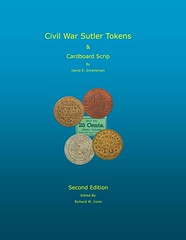 Civil War Sutler Tokens & Cardboard Scrip
Civil War Sutler Tokens & Cardboard Scrip
by David E. Schenkman
Second Edition Edited By Richard W. Irons
The 1st Edition of Civil War Sutler Tokens & Cardboard Scrip by David E. Schenkman was published in 1983. After over 30 years I thought it was time for a 2nd edition and when I found out it wasn’t on Dave Schenkman’s front burner I decided I really wanted to do it.
The book has large color pictures including at least one denomination of every variety (except for a few non-local’s (now called Unidentified) that haven’t been seen since the 1st edition. There are lots of new varieties as well as additional denominations for known varieties.
Steve Hayden is the Rarities and Valuations Editor – a number of rarities have been changed – both up and down – and there are estimated valuations for almost all the varieties. Revised rarities and valuations were developed by Steve Hayden from his database of over 3,000 Sutler token transactions over the last 20 years along with notes kept by Steve Tanenbaum while compiling his extensive collection of Sutler tokens. Also, many of the pictures are of tokens from the Tanenbaum Collection.
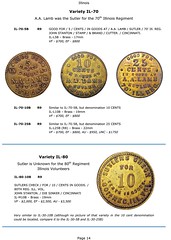

Retail price of $99.95
Hardcover
241 pages
Can be purchased by sending a check for $99.95 to -
Richard W Irons
P.O. Box 4482
Lancaster, PA 17604-4482
If there are any questions or if someone wants to pay using PayPal they can email me at rwirons@comcast.net or go to www.sutlertoken.com. This website will also be used to list any errors found in the book, new tokens discovered after the book is published and to post research on Sutler Tokens.
To read the earlier E-Sylum article, see:
NEW BOOK: GUIDE BOOK OF CIVIL WAR TOKENS, 2ND EDITION
(www.coinbooks.org/esylum_v17n43a03.html)
NEW BOOK: LA COLECCIÓN CERVERA, MONEDA ANTIQUA DE HISPANIA
 La Colección Cervera, Moneda Antiqua de Hispania
La Colección Cervera, Moneda Antiqua de Hispania
By: Ma Paz García-Bellido y William Metcalf
Con la participatión de Gloira Mora y la colaboración de Encarnación González
Published by:
Consejo Superior de Investigaciones Científicas and
Ediciones Polifemo
Madrid, 2014
Softcover, 468 pp.
(Spanish)
Bl & wh illustrations throughout I
SBN: 978-88-7794-835-9
Price: Non-member price: US$90.00 plus shipping and handling
Member price: US$60.00 plus shipping and handling
Dealer price: US$60.00 contact the ANS Membership Office for details
The provenance of individual coins can sometimes be traced back to great collections of earlier centuries, but it is very rare that the entire contents of a coin collection from the nineteenth century are fully documented. It is fortunate for the numismatic community that one such instance is the outstanding collection formed by the Spanish ophthalmologist Rafael Cervera y Royo (1828–1903). In 1902, shortly before his death, Cervera sold his collection in its entirety to the great American Hispanophile Archer M. Huntington, along with a manuscript inventory listing the entire collection. That inventory, now at the American Numismatic Society in New York, together with the rubbings of Cervera’s collection made by Antonio Vives Escudero for his research on ancient Spanish coins, now at the Instituto Valencia de Don Juan in Spain, allowed María Paz García-Bellido and William E. Metcalf to identify the ancient coins from Cervera’s collection and match them with the photographs of Archer Huntington’s collection.
This book catalogues the 1576 Iberian, Celtiberian, Greek, Hispano-Punic, and Roman Provincial coins from the Cervera collection, with every coin photographed and fully described. After the unfortunate dispersal of Archer Huntington’s collection in a series of sales since 2011, this book stands as the surviving monument to Cervera’s collection and the best resource for tracing its coins into the future. It is not only an astonishing time capsule of one of the great collections of nineteenth-century Spain; the importance of this collection for researchers working on early Hispanic coinage, from Vives to the present, makes this book an essential resource for any numismatist with an interest in ancient Spain.
For more information, or to order, see:
http://numismatics.org/Store/Cervera
BOOK REVIEW: CASH IN YOUR COINS, 2ND EDITION
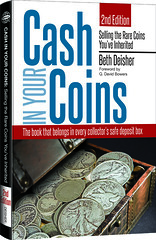 Cash in Your Coins: Selling the Rare Coins You’ve Inherited 2nd Edition, by Beth Deisher, Whitman,
2014, 304 pages, $9.95.
Cash in Your Coins: Selling the Rare Coins You’ve Inherited 2nd Edition, by Beth Deisher, Whitman,
2014, 304 pages, $9.95.
The punning title could be an indication of the double purpose that this book can serve. It is intended for the person who knows nothing about numismatics. Although I do know something, I found Cash in Your Coins enlightening. I am ignorant in many areas of U.S. numismatics. When I worked for Coin World as their international editor, Bill Gibbs assigned me several tutorials in American numismatics. I had to produce publishable work on topics such as the pattern coins of 1792, the Paquet double eagles, and national currency paper money. So, for me, this book is useful, independent of its intended audience, those who have inherited a coin collection.
I believe that the core of the presentation includes information that should be in the Red Book. The Red Book credits the Large Cents 1796-1807 to Robert Scott. Deisher nods to Gilbert Stuart and John Eckstein for the obverse and Joseph Wright for the reverse. In that, Deisher agrees with Breen and Taxay; argue it as you wish. I can recommend this book highly to anyone collecting the broad spectrum of American coins.
Perhaps the strongest feature of Cash in Your Coins is its suggestion that the new owner of someone else’s trove start with Lincoln Cents. Any collection is likely to have pounds of them in jars or cans. Sorting them and searching through them will provide a basic introduction to numismatics as a collecting hobby. It also will foreshadow the real work of evaluating a large collection.
Of course, numismatics is more than "coin collecting"; and American federal coins are just one interest area. However, statistically, most Americans collect American coins. So, of necessity, the chapter on paper money is cursory, beginning with the Federal notes of the Civil War. Tokens, medals, and foreign coins are all in one chapter. Ancients are not addressed at all, except to contrast the ubiquitous Widow’s Mite with the 1995-W Silver Eagle in Chapter 10, "Determining Value."
Of all the quibbling that could resonate with E-Sylum readers, I found the use, over-use, misuse, and abuse of quotation marks annoying. However, when I worked at Coin World, Beth Deisher was two tiers above me, so I have to consider that modern English is what the editors say it is. Once, writing documentation for some software engineers, I pointed out to one that he was not even following the high school grammar books. He replied that languages change before the new style is accepted by academics. "So," he said, "if you are following the manual, then you are not using the current version."
A more substantial problem for me was the lack of important information about pricing at the opening of the narrative. Deisher cites the Red Book several times, never warning the reader until pages 210-211 that dealers do not pay Red Book prices. Finally, in Chapter 10 she does nicely dissect the distinctions among the Red Book, Blue Book, Greysheet, and Bluesheet. You cannot say everything all at once on Page 1 but some forewarning could easily point to the later details.
Although Deisher does identify important repunched dates for various issues, the term is never defined or explained. The discussion of die doubling, for example on page 48 for the famous 1955 Lincoln Cent, is cursory. It would not be a problem except that so many collectors are optimistic; and it is reasonable to expect that many collections are infected with misidentified "die chatter", if not for this one example, then for many other instances.
Similarly, it is not until Chapter 8, on page 169, amid the private tokens and medals, that Deisher alerts the ignorant inheritor of the likely presence of fakes. Any large accumulation can have several or many, too often unidentified.
That brings me back to why it is so easy to endorse this book for its substantive content. I failed the test on page 169. Clearly, I do not know what a Morgan Dollar looks like. I have one on my desk, but the test was not to compare mine to two pictures; but to choose between the illustrations. I failed. So, for me, this book is an important addition to my library and will sit next to the Red Book.
To read the earlier E-Sylum article, see:
NEW BOOK: CASH IN YOUR COINS, 2ND EDITION
(http://www.coinbooks.org/esylum_v17n35a03.html)
THE BOOK BAZARRE
NEWMAN NUMISMATIC PORTAL LAUNCHES IN 2015
Online coin and currency research tool to be established at Washington University
Newman Numismatic Portal launches in 2015
December 11, 2014
 Washington University in St. Louis and the Eric P. Newman Numismatic Education Society (EPNNES) have announced plans to create the Newman Numismatic
Portal, an online research tool that will become the ultimate go-to resource for the study of coins and currency. A commitment of $2 million from
EPNNES will support the project.
Washington University in St. Louis and the Eric P. Newman Numismatic Education Society (EPNNES) have announced plans to create the Newman Numismatic
Portal, an online research tool that will become the ultimate go-to resource for the study of coins and currency. A commitment of $2 million from
EPNNES will support the project.
"I have long wanted to make the literature and images of numismatics, particularly American numismatics, available to everyone on a free and forever basis," said Eric P. Newman, president of EPNNES. "Today’s digital technologies, combined with the funds recently assembled from auctions of some of our foundation’s holdings, now make this possible."
Newman is among America’s most distinguished numismatic scholars and a 1935 graduate of Washington University School of Law. He has written more than 100 articles and several volumes on numismatic subjects, including many of the standard reference books in the field. He began collecting coins nearly a century ago and built one of the nation’s strongest private collections of U.S. and Colonial American coinage and paper money.
Newman and his wife, Evelyn, made a major gift in 2004 to establish the Newman Money Museum at the Sam Fox School of Design & Visual Arts at Washington University.
"We are proud to be involved in the creation of the Newman Numismatic Portal, which is made possible by the generosity of EPNNES," Chancellor Mark S. Wrighton said. "The study of numismatics involves many disciplines, from art to metallurgy, economics, politics and history. Making these significant scholarly resources widely accessible for the first time will elevate numismatic research to a new level."
Washington University Libraries will launch a preliminary version of the Newman Numismatic Portal in 2015. "The project will begin by digitizing Eric Newman’s extraordinary collection of books, periodicals and correspondence on numismatics, as well as images of coins and currency," said Jeffrey Trzeciak, university librarian. "We also are undertaking discussions with libraries, publishers, auction companies, and others in the field of numismatics to make the new online resource as comprehensive as possible."
Said Wayne Homren, past president of the Numismatic Bibliomania Society and editor of The E-Sylum, "I am delighted to bring my CoinLibrary numismatic search and organization project to this effort and welcome the great boost that this commitment provides to numismatic scholarship." Anyone wishing to provide materials for inclusion in the project is encouraged to contact NNPCurator@wustl.edu.

Chris writes:
I just saw this article and saw that you had a quote in it and are going to be involved with it. When will it go live? Will the public be able to use it? What will be in it? Looks real interesting!! Can you keep us updated on this?
To read the complete new release, see:
http://news.wustl.edu/news/Pages/27786.aspx
THE HISTORY OF THE COIN LIBRARY
Back in the early days of the Internet, I built the first NBS web site to teach myself HTML. Then I wanted to try building a site of my own and purchased the coinlibrary.com domain. I set up a small site with my numismatic biography, a numismatic literature want list, some books for sale and a few articles, including one on the In God We Trust motto. My plan was to keep building out numismatic content, but life soon got in the way (namely a wife and kids).
While I continued editing The E-Sylum, my web site gathered dust for years on end. It was embarrassing, but I renewed the domain name over and over, figuring that someday I'd do something with it.
Fast forward to May 18, 2008. On that Sunday, the new HTML version of The E-Sylum debuted. John Nebel had done a lot of development work for me behind the scenes, and we had a pretty slick system in place. Every Sunday night, after our webmaster Bruce Perdue uploads a new E-Sylum issue, John's programs run automatically and split the issues into individual web pages and update the table of contents on our archive.
The programs also create our RSS feed and an email message that lists the headline, volume, number, article number, and URL for every new E-Sylum article. That email message was the genesis of the new CoinLibrary.com, but not directly. You see, that email message went nowhere but my inbox (and trash folder). There was nowhere else to send it.
The idea of that message was to feed the latest E-Sylum articles into NIP, the Numismatic Indexes Project started by Harry Bass. Harry had hired a developer and built a database containing indexes to major U.S. numismatic periodicals, including The Numismatist, the American Journal of Numismatics, and many others. The database could be searched online at the Harry Bass Foundation web site. It was a MARVELOUS resource. I worked with Harry and his developer to include both our print journal (The Asylum) and our electronic newsletter (The E-Sylum).
The problem with any periodical index is that it gets out of date very quickly. Some volunteer spends months compiling one, publishes it, then quits. New content continues to be published, but the index languishes until another volunteer brings it up to date years later.
The email was to be the solution to that problem, at least for The E-Sylum. It would go to the NIP database administrator, who could easily pull it into the database, keeping the index fully up to date with the latest articles. My Master Plan was to work with the editors of all the major U.S. numismatic periodicals to send a similar email for each of their issues. Voila! NIP would never get out of date.
Just one problem. Harry died. The Foundation continued to host the NIP index, but there was no one to update it. Eventually they gave it to the American Numismatic Association, and they hosted it for several years on their site. But still, no updates were ever made that I'm aware of. The index was was quite useful, but hadn't been updated in years. And with the latest ANA web site revamp, NIP disappeared.
Basically, I wanted to pick up with Harry left off and build a new numismatic literature index, only now I could do it with 21st century tools. In the age of Google and Open Source software, far more was possible. I wanted to build the Mother of All Numismatic Search Engines; one that could stay completely current, enable full text content search, and have redundant backups so no information would ever get lost.
Some sites like CoinArchives already exist, but they focus on ancient coins and most do not have books or periodicals, just auction records. I wanted to start with U.S. material, especially specialty club periodicals, which have a wealth of great information rarely seen by people outside those clubs.
 I found a
developer to help and he built a marvelous demo site. It included full-text search on all 17,000+ E-Sylum articles, the NIP index, and all the
auction lots on the Heritage and Goldbergs web sites. I went to a Baltimore coin show and gave a PowerPoint overview with screen shots to several NBS
friends, including David Sundman, Dave Perkins and Len Augsberger. Later I gave them logins on the demo site so they could play around.
I found a
developer to help and he built a marvelous demo site. It included full-text search on all 17,000+ E-Sylum articles, the NIP index, and all the
auction lots on the Heritage and Goldbergs web sites. I went to a Baltimore coin show and gave a PowerPoint overview with screen shots to several NBS
friends, including David Sundman, Dave Perkins and Len Augsberger. Later I gave them logins on the demo site so they could play around.
That first developer did the work for free, but I had begun raising funds to pay for the other services I would need, like a user interface designer, a tester, not to mention an accountant to help with taxes. I had set up a company and the idea was to sell advertising on the site to pay the bills.
When Harvey Stack wrote to me praising The E-Sylum and asking how he could help, I told him about my new web site project. He immediately sent a check. Others soon joined in, including John Adams, Dan Hamelberg, John Kraljevich, David Sundman, Dave Bowers, Tony Terranova, Ken Bressett, Bill Burd and Greg Roberts. I treated these contributions as prepayment for ads once the site went live.
These funds came in handy when my first developer took a new job and didn't have time to continue. I found someone new and could begin paying him and a web designer. Together we began putting a cleaner interface on the site and adding new features, including indexing complete books and indexing Heritage auctions from the files they'd begun sending me. Roger Burdette allowed me to test with a digital copy of his From Mine to Mint book, and Dennis Tucker at Whitman Publications provided digital copies of two Whitman publications. The system worked - we could do a fast full-text search across books, periodicals and auction sites.
One evening I got a call from Eric Newman's son Andy, asking the same question Harvey did. "First, let me tell you about this other project...", I said. And to make a long story short, that's how the Coin Library project came to be a part of what is now called the Newman Numismatic Portal. After the press release came out the other day, I sent the following note to all of my supporters to date:
Dear Friends of Coin Library:
Attached is a copy of a release that went out today to the numismatic, academic and general press. In summary, The Coin Library is becoming part of an even more ambitious project, the Newman Numismatic Portal, funded by the Eric P. Newman Numismatic Education Society (EPNNES). This is an exciting opportunity to take numismatic digitization and search to the next level, combining the organization features of Coin Library with the substantial digitization capacity that a university library can provide.
The lion’s share of the grant to Washington University in St. Louis (WUSTL) will provide equipment and staffing to enable the digitization of millions of pages of numismatic literature, far more than we could ever hope to digitize on our own. The university library will also enable the integration of numismatic content in JSTOR, the HathiTrust, EBSCO Host and other valuable databases.
Your generous contributions, helpful comments, and unflagging support for Coin Library have made this project possible – a project that will serve not only the numismatists of today, but the numismatic scholars and collectors of generations to come.
As promised, your contributions will be acknowledged publicly on the web site when it goes live. As early backers of this project you will continue to have a front-row seat as it evolves. When appropriate I will furnish project updates and chances to "test drive" new features and content.
Unspent funds already contributed to The Coin Library will be used as originally intended, to continue building out the planned software features for the first version. Meanwhile, Len Augsburger, Roger Burdette, John Feigenbaum, Joel Orosz and I will work with the university to direct digitization efforts and plan the full set of features for the portal, to include a free "Coin Facts"-style encyclopedia of U.S. numismatic data.
Many thanks to our longtime friend Eric P. Newman for his generous support. Through this project America’s greatest numismatic scholar is creating the ultimate resource for future numismatic researchers. I’m proud to be a part of it, and you should be, too. Thank you for believing and investing in the vision. I’ll look forward to working with all of you in the months and years ahead as the pieces fall into place.
Wayne Homren
Many thanks to Eric Newman and the Newman family for making the new project possible. Together with the university we'll take this to the next level, beginning with the digitization of material from Eric's marvelous library. Thanks also to Andy Newman, Bill Eckberg, Heather Schena, Joel Orosz, John Nebel, John Sallay, Len Augsburger, Mary Burleson, Mike Paradis, Roger Burdette and Dennis Tucker, whose comments and suggestions along the way were invaluable.
Stay tuned, everyone! We'll provide more information as the project evolves. It should prove to be a marvelous source for numismatic researchers, regular collectors, and everyone in between.
THE BOOK BAZARRE
NOTES FROM E-SYLUM READERS: DECEMBER 14, 2014
Royal Succession and the State Mourning Period
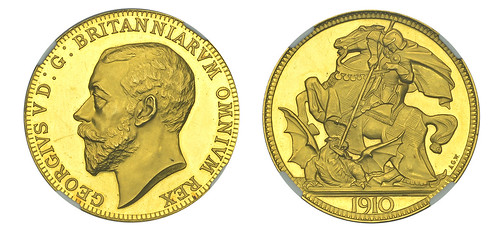
David T. Alexander writes:
The report on the glorious 1910 pattern gold crown of King George V highlights a significant constitutional issue. The new monarch becomes ruler the moment his or her predecessor dies. Legally the throne is never vacant, but traditionally the Coronation follows a year of state mourning and in effect ceremonially ratifies the succession that has already been achieved. It would have been in poor taste to strike any coin for George V bearing the date of his father's death.
I asked Philip Mernick for a Londoner's opinion on this. He writes:
Yes, George V became King on 6th May 1910, the same day his father died. But only for 15 minutes of that day as Edward VII died at 11.45 P.M. I don’t actually know if it was considered bad taste to use the year of death of the previous monarch but the first coins of a reign were dated with the coronation year throughout the 20th century. You would probably have to ask the Royal Mint for the official position.
To read the earlier E-Sylum article, see:
SELECTIONS FROM THE DIX NOONAN WEBB FEBRUARY 2015 SALE
(www.coinbooks.org/esylum_v17n50a18.html)
A Lucite-Encased Prince Edward Island Cent
 Alan Roy writes:
Alan Roy writes:
I thought it would be a good idea to keep this topic targeted on numismatic books. This encased PEI cent was issued in 1988 to commemorate The release of The Currency and Medals of Prince Edward Island by Robert J. Graham, Earle K. Kennedy, J. Richard Becker. I believe they were presented to contributors and authors.
To read the earlier E-Sylum article, see:
MORE LUCITE-ENCASED COINS: SPELLMAN, BEISTLE
(www.coinbooks.org/esylum_v17n49a15.html)
McDermott's 1913 Liberty Nickel at the 1954 ANA
New subscriber Bill Sponseller writes:
I recall attending the 1954 ANA convention in Cleveland, Ohio. People had gathered around McDermott who pulled the 1913 Liberty Head Nickel OUT OF HIS POCKET !! Claimed he had paid $10,000 for it. Never heard of a coin selling for that much at the time.
Recognizing Howard Daniel
Larry Gaye writes:
Hooray for Howard Daniel III. Nice news item and well deserved recognition.
To read the earlier E-Sylum article, see:
SAIGON TIMES INTERVIEWS AUTHOR HOWARD DANIEL
(www.coinbooks.org/esylum_v17n50a10.html)
Demarest’s "Declaration of Independence" Medal
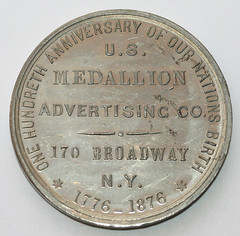
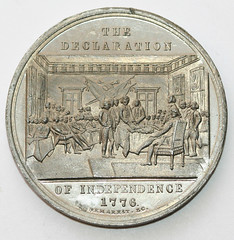
David Schenkman writes:
Ron Abler, in his catalog of Centennial medals (www.centennialmedals.com), lists several reverse varieties of A. Demarest’s "Declaration of Independence" medal but not this one. I have no information on the U.S. Medallion Advertising Company, which was located on the same block of Broadway as Demarest. However, Ron illustrates a newspaper ad for a U.S. Medallion Company at 212 Broadway, offering "Centennial Memorial Medals" and depicting the Demarest obverse. The 42mm medal is struck in white metal.
Documents & Engravings about the Boston Massacre
Anne E. Bentley of the Massachusetts Historical Society writes:
We have a new component to our website, and while it isn’t numismatic in nature, it deals with a pre-revolutionary event that might interest your readers who collect Colonial American coins and medals.
It is interesting to read the words of people who were either at the scene or were able to comment on the overall atmosphere of the town after the event. Thanks to funding from the Massachusetts Society of the Cincinnati, the MHS has created a new web presentation, Perspectives on the Boston Massacre, featuring letters, pamphlets, diary entries, legal notes, and engravings relating to the Boston Massacre.
Some examples of the manuscripts that are available for browsing and reading include diary entries written by merchant John Rowe who observed, "the Inhabitants are greatly enraged and not without Reason" and a letter dated 6 March 1770 by Loyalist Andrew Oliver, Jr. who wrote, "Terrible as well as strange things have happen'd in this Town." The website also includes printed materials; some convey the Patriot perspective of the event (A Short Narrative of the Horrid Massacre in Boston and On the Trial of the Inhuman Murderers) and some the Loyalist view (A Fair Account of the Late Unhappy Disturbance at Boston).
One section of the new web presentation focuses on visual representations of the Boston Massacre. Seven prints of the event, as well as one painting showing the same location in Boston in 1801, are available for close examination. Website visitors can use a comparison tool to view any two of the featured images side by side.
To read the complete article, see:
New Web Presentation of Documents & Engravings about the Boston Massacre
(www.masshist.org/blog/1162)
QUERY: 1838-O HALF DOLLARS SOUGHT FOR RESEARCH
 I
am writing a book on the 1838-O half dollar. I have been in touch with Mark Van Winkle and David Stone from Heritage about their information. I can
prove none were struck in Philadelphia. I can show when they were struck and why they were struck. I present and evaluate all possible theories and
present all facts, conclusions, unknown, and what is untrue.
I
am writing a book on the 1838-O half dollar. I have been in touch with Mark Van Winkle and David Stone from Heritage about their information. I can
prove none were struck in Philadelphia. I can show when they were struck and why they were struck. I present and evaluate all possible theories and
present all facts, conclusions, unknown, and what is untrue.
Last week I studied and photographed the Smithsonian Institution specimen, which I believe was struck after the initial ten. There are over 10 different die cracks on this specimen, which I believe proves it is the latest die state. The four different specimens listed by Heritage only show one of the die cracks, but it is possible that the lower photo quality or the fact that the coins are flat when photographed can obscure the die cracks when viewed from a 90 degree angle. The SI specimen also has a mirrored reverse, which I do not believe is seen on the others.
I would like to examine or have compared my images from the SI coin to other 38-O half dollars if possible. I am trying to have this book done by Christmas. I've already written about 62 pages, found a bunch of archive letters that shed light on these coins and their history.

1795 MASSACHUSETTS STATE HOUSE TIME CAPSULE
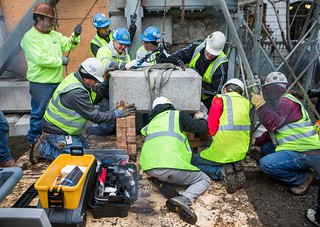 After a full day spent lying on her back on a muddy wooden plank, chipping with painstaking care at
the underside of a stone block to free the time capsule hidden within, Museum of Fine Arts conservator Pam Hatchfield sat up in front of the State
House to a round of applause, a green box held delicately in her hands.
After a full day spent lying on her back on a muddy wooden plank, chipping with painstaking care at
the underside of a stone block to free the time capsule hidden within, Museum of Fine Arts conservator Pam Hatchfield sat up in front of the State
House to a round of applause, a green box held delicately in her hands.
"I feel happy and relieved. And excited. And really interested to see what’s in this box," she said Thursday night, after posing for a selfie with the capsule for her mom. The extrication took more than seven hours and involved about a dozen workers.
The original contents of the time capsule were first placed in 1795 by Governor Samuel Adams, Paul Revere, and William Scollay in a ceremony that started in downtown Boston and proceeded to the State House, according to historical accounts. It was unearthed during emergency repairs to the foundation in 1855 and then buried again, and had not seen daylight until it emerged on Thursday.
"Hopefully there will be no damage and we will be able to observe the artifacts that trace us back to the history not only just of this building, but of our Commonwealth and our country," said Secretary of State William Galvin, who was on hand for the capsule’s first appearance in more than 150 years.
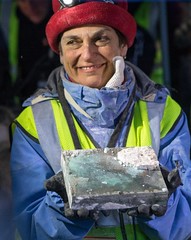 The capsule is believed to include a collection of silver and copper coins dating from
between 1652 and 1855; an engraved silver plate; newspapers; the seal of the Commonwealth; cards; and a title page from the Massachusetts Colony
Records, according to Meghan Kelly, a spokeswoman for the Executive Office of Administration and Finance.
The capsule is believed to include a collection of silver and copper coins dating from
between 1652 and 1855; an engraved silver plate; newspapers; the seal of the Commonwealth; cards; and a title page from the Massachusetts Colony
Records, according to Meghan Kelly, a spokeswoman for the Executive Office of Administration and Finance.
The box was taken by State Police escort to the Museum of Fine Arts, where Hatchfield said it will be X-rayed to determine the contents. There was some concern, Galvin said, that there may be some damage to some of the coins, which may have been washed in acid before the box was reburied in 1855.
"It will be opened probably sometime next week," said Galvin. The contents will be examined, he said, but the time capsule will not remain unburied. "Ultimately it will be put back in the box and ultimately back in the stone."
Galvin said officials have not yet decided whether they will add any objects to the capsule before re-burying it. The capsule was discovered during the course of a water infiltration investigation at the State House, which identified the corner where it was hidden as an area of concern.
It is believed to be one of the oldest time capsules in the state, according to Kelly. In October, a century-old time capsule was opened after it was removed from its perch in the head of a golden lion statue that had sat atop the Old State House in downtown Boston. Its contents included sealed letters, photographs, and newspaper articles in near-perfect condition.
To read the complete article, see:
State House time capsule from 1795 unearthed
(/www.bostonglobe.com/metro/2014/12/11/officials-attempting-remove-massachusetts-state-house-time-capsule-from/GqKAGMB8zvxF6F3L7tWBpM/story.html)
SOME RECENT AUCTION ITEMS: INDIAN PEACE AND PICASSO MEDALS
1857 Silver James Buchanan Indian Peace Medal
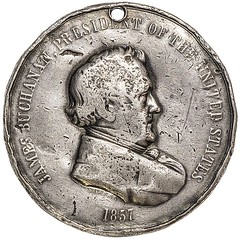
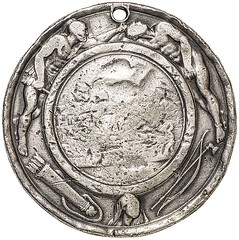
1857 President James Buchanan Indian Peace Medal, 62 mm. Small Size. Struck in Silver. Extremely Rare. Fine to Very Fine.
Julian IP-35. Belden-51. Prucha-50. 62 mm. Struck at the United States Mint on behalf of the Commissioner of Indian Affairs for distribution to Indian Chiefs and high officials. This example has seen actual wear and is holed at the top for suspension, as always. Both sides show numerous edge bumps, appearing quite similar to the piece offered in the 1986 Dreyfuss Sale (which realized $5,060 in that long-ago sale, nearly three decades ago).
Julian indicated that this size may only have been struck in Silver, but since the publication of his "Medals of the United States Mint" in 1977, a very few Bronze pieces have appeared. In his 1986 supplement, Rich Hartzog could find only seven records of this 62 mm size and Silver metal combination appearing at auction.
Dick writes:
The Indian Peace Medal has a new condition term - RBU - Really Beat Up. Makes you wonder what happened to the Indian who wore it.
To read the complete lot description, see:
Lot 390: 1857 SILVER JAMES
BUCHANAN INDIAN PEACE MEDAL Julian IP-35 62 mm Extremely Rare
(www.invaluable.com/auction-lot/1857-silver-james-buchanan-indian-peace-medal-jul-390-c-eb81fc70f0)
Pablo Picasso medal
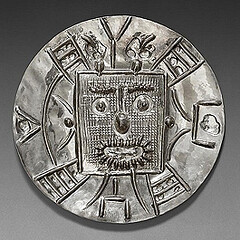
Dick writes:
The Picasso is a Medallic Object. Picasso was a forerunner in the modern art medallic field, ahead of his time and ahead of other artists for applying modern art to the medallic format.
THE BOOK BAZARRE
EVERGLADES NATIONAL PARK QUARTER LAUNCH
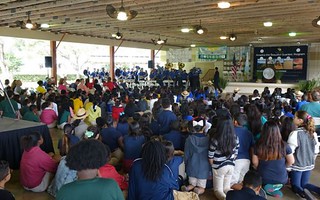 On Thursday, Dec. 4, 2014, the National Park Service and United States Mint officially
introduced Everglades National Park Quarters to a crowd of over 1,000 people.
On Thursday, Dec. 4, 2014, the National Park Service and United States Mint officially
introduced Everglades National Park Quarters to a crowd of over 1,000 people.
Thursday’s event took place near the national park in Florida which is depicted on the coin’s reverse.
"A vast mosaic of habitats that protects a thousand plant and bird species, Everglades National Park is the perfect choice to represent Florida in the America the Beautiful Quarters Program," said Beverly Ortega Babers, United States Mint Chief Administrative Officer.
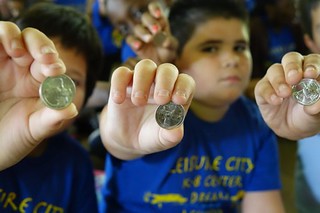 Babers and other officials later handed out Everglades National Park quarters to about
700 schoolchildren who attended the ceremony.
Babers and other officials later handed out Everglades National Park quarters to about
700 schoolchildren who attended the ceremony.
Following the event, attendees swapped cash for $10 rolls of the new coin. $21,000 in quarters were exchanged.
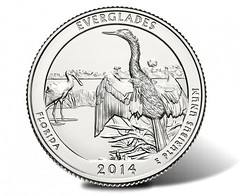 Designed by Joel Iskowitz and sculpted by Joseph Menna, the coin depicts an anhinga with outstretched wings
on a willow tree with a roseate spoonbill in the mid-ground.
Designed by Joel Iskowitz and sculpted by Joseph Menna, the coin depicts an anhinga with outstretched wings
on a willow tree with a roseate spoonbill in the mid-ground.
Joel Iskowitz writes:
I really appreciate your kind words about my design for the Everglades ATB Quarter Dollar. I bought the 5oz version and Joe Menna's sculpt makes it look like an art medal at that scale with a substantial sense of relief.
To read the complete article, see:
Everglades National Park Quarter Ceremony
Highlights (www.coinnews.net/2014/12/08/everglades-national-park-quarter-ceremony-highlights/)
JOEL ISKOWITZ ON HIS FALLEN HEROES DESIGN
Steve D'Ippolito wrote:
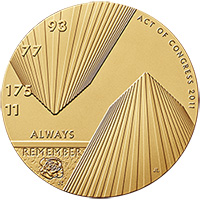 Although the New York 9/11 medal is a striking design, the faulted perspective isn't properly executed--the artist took quite a liberty here ...
I'm sure the artist did this deliberately, because it's simply too glaring to be a mistake. While I heartily endorse the desire to
memorialize what was destroyed on that awful day (I did buy one of the medals myself) I found the incorrect perspective very distracting. It suggests
to me the towers caught in the act of toppling almost toward each other (even though they didn't).
Although the New York 9/11 medal is a striking design, the faulted perspective isn't properly executed--the artist took quite a liberty here ...
I'm sure the artist did this deliberately, because it's simply too glaring to be a mistake. While I heartily endorse the desire to
memorialize what was destroyed on that awful day (I did buy one of the medals myself) I found the incorrect perspective very distracting. It suggests
to me the towers caught in the act of toppling almost toward each other (even though they didn't).
I am appreciative of Mr.D'Ippolito's comments, calling my design a striking one. He is correct in stating that I "took quite a liberty here." Let me assure you that the liberty I took with traditional perspective was entirely purposeful.
I am fully aware of the rules of academic perspective. To the extent that these lines evoke the twin towers (which was one of my intended concepts albeit a secondary one), I deliberately inverted the lines on the left which are facing downward ( inverted vaulted perspective or aerial perspective) to indicate great, unspeakable loss.
This was meant to be symbolic of the fact that that day, as Americans our world was literally turned upside down.
Juxtaposed, are the lines on the right which rise upward (vaulted perspective) which are intended to be emblematic of hope and perseverance, rising above the these tragic events.
Furthermore I wanted to create a sense of vertigo to underscore our collective sense of disorientation and confusion on that morning when we experienced and witnessed unimaginable horror.
In that regard I am encouraged that Mr.D'Ippolito felt distracted, as this is certainly not a design intended to merely reproduce the towers as they stood before we were attacked.
I appreciate that Mr.D'Ippolito seems to understand that this was precisely the concept I was trying to convey.
Mr. Lange makes a valid point as well, as the twin towers are evoked as a leitmotif, but again the inverted tower on the left is about the collapse and loss, while the tower on the right is about rebuilding, renewal and the undaunted American spirit.
Dick Johnson was entirely correct in referring to the rising of the new tower which the lines on the right are meant to evoke as well.
While we as a nation will rise above this infamous day, we will "Always Remember" the innocent victims and the heroes that lost their lives.
I hope everyone understands the symbolism of the placement of the flight numbers and the rose on the parapet wall.
To read the earlier E-Sylum articles, see:
FALLEN HEROES MEDAL DESIGN: VAULTED PERSPECTIVE
(www.coinbooks.org/esylum_v17n48a13.html)
ON PERSPECTIVE IN MEDAL DESIGN (www.coinbooks.org/esylum_v17n49a12.html)
U.S. MINT PROFILES MEDALLIC SCULPTOR JOSEPH MENNA
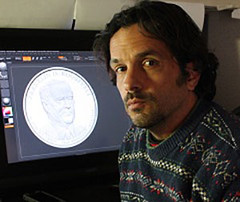 Joe Menna joined the
roster of United States Mint artists as a medallic sculptor in 2005 following 18 years of professional experience and classical art training. Joe was
the first full-time digitally-skilled artist hired by the Mint and his skills in traditional and digital sculpture have helped make the United States
Mint a world leader in digital coin design and production. The 2013 Mount Rushmore National Memorial Quarter (shown below) that Joe designed recently
won a Coin of the Year Award, an awards program sponsored by Krause Publications, in the category of Best Circulating Coin.
Joe Menna joined the
roster of United States Mint artists as a medallic sculptor in 2005 following 18 years of professional experience and classical art training. Joe was
the first full-time digitally-skilled artist hired by the Mint and his skills in traditional and digital sculpture have helped make the United States
Mint a world leader in digital coin design and production. The 2013 Mount Rushmore National Memorial Quarter (shown below) that Joe designed recently
won a Coin of the Year Award, an awards program sponsored by Krause Publications, in the category of Best Circulating Coin.
In addition to his work at the United States Mint, Joe maintains an active freelance career and is recognized as one of the world's leading practitioners of digital sculpture.
Here's how Joe describes his eight years at the Mint: "I was lucky to be the first digital artist at the Mint and so have had the opportunity to introduce a lot of new techniques and technology to how we make coins. It has been an honor and a privilege, and I only see us continuing to grow in that direction as we move forward in our mission."
We asked Joe about his own favorite coin and medal designs and what he does when he isn't working.
Question: Which of your coin or medal designs is your favorite?
Joe: My all-time favorite design and sculpt is the obverse of the Flight 93 Heroes of 9/11 Congressional Gold Medal (shown above).
Question: What has been your favorite coin series?
Joe: My favorite coin series has been the Presidential $1 Coin program. I did the George Washington obverse, the first one in the series, and
have done a few more since then.
Question: What are your interests outside your job at the Mint?
Joe: My main interest outside the Mint is my family. My wife is also an artist and we have three amazing kids. They are my heart and soul.
To read the complete article, see:
No Ordinary Joe: Joseph Menna, Medallic Sculptor
(www.usmint.gov/pressroom/insidethemint/index.cfm?action=Joe-Menna)

HAYDEN ACQUIRES TANENBAUM GOOD-FOR TOKENS
After months of work we are pleased to announce the purchase of the Steve Tanenbaum collection of Good For tokens. This huge purchase contains well over 20,000 metal Good For and other tokens mainly from the Northeast. They will be sold over a number of years through eBay and by want list. Although a few areas are already reserved, now is the time to send want lists. We will first concentrate on larger transactions (by dollar or quantity). So if you want one token from a grandfather's store or your home town, you may have to wait but if your are interested in all the good for tokens from Buffalo New York (or Albany, NYC etc.), you move to the front of the line.
Stephen L. Tanenbaum was a great friend and the foremost dealer and collector of tokens in this or any other century. Ever a fountain of knowledge, he seemed to know everything about almost everything. He met a tragic end all too soon and though he died nearly four years ago, he is remembered daily. Here is a partial listing of some of the items recently purchased from his estate:
- Over 2,000 Communion tokens mainly Scottish, a few Canadian and even fewer US
- Over 10,000 New York good for tokens with duplicates
- Over 2,000 Connecticut good for tokens with duplicates
- Over 1,200 Transportation tokens mainly New York with duplicates and traders
- Over 1,400 Massachusetts good for tokens with duplicates
- Over 1,000 New Jersey good for tokens with duplicates
- Over 700 Rhode Island good for tokens with duplicates
- Over 300 Delaware good for tokens with duplicates
- Over 300 Maine good for tokens with duplicates (many more also purchased and sold earlier)
- Over 200 Vermont good for tokens with duplicates
- Over 200 Washington DC good for tokens (many more also purchased and sold earlier)
- Over 200 Hard Rubber tokens
- Over 200 Parking and Car Wash tokens
- Over 100 Tire / Battery / Radiator good for tokens from across the country
- Over 1,000 Good For tokens from across the country as traders and dealer stock
- A collection of tokens issued by local politicians and office seekers from across the country
- A small collection of Menter and Menter & Rosenbloom tokens from across the country
- A number of (collection?) Cure All tokens
- A few Indiana early good for tokens (most were purchased earlier and have been sold)
- A few New Hampshire good for tokens (most were purchased earlier and have been sold)
- And many, many, many more.
Steve Hayden
steve@civilwartokens.com
civilwartokens.com
PO Box 22514
Charleston, SC 29413
SOME INTERESTING TOKENS: DECEMBER 14, 2014
St. Paul Ice Palace Token
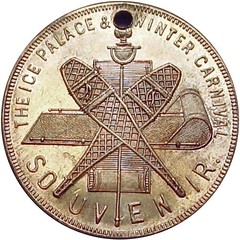
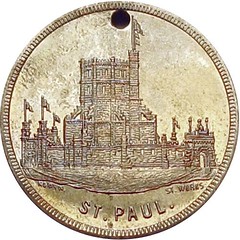
St. Paul Minnesota Souvenir Token. The Ice Palace & Winter Carnival Souvenir with images of toboggans and snowshoes on obverse. St. Paul with image of the ice palace on reverse.
To read the complete lot description, see:
www.ebay.com/itm/St-Paul-Minnesota-The-Ice-Palace-Winter-Carnival-Souvenir-Token-/221626136997
Columbus Cure All Token
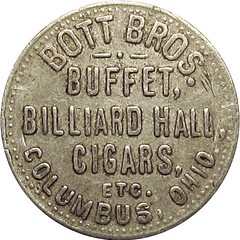
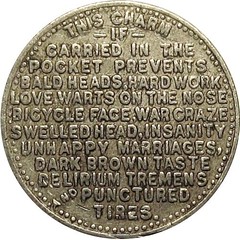
Columbus Ohio Cure All Good For Token. Bott Bros. Buffet, Billiard Hall, Cigars, Etc. Columbus, Ohio.
This Charm If Carried In The Pocket Prevents Bald Heads, Hard Work, Love Warts On The Nose, Bicycle Face, War Craze Swelled Heads, Insanity, Unhappy Marriages, Dark Brown Taste, Delirium Tremens And Punctured Tires.
To read the complete lot description, see:
www.ebay.com/itm/Columbus-Ohio-Cure-All-Good-For-Token-Bott-Bros-Buffet-Billiard-Hall-Cigars-/381075133066
Selma Circus and Balloon Show Token
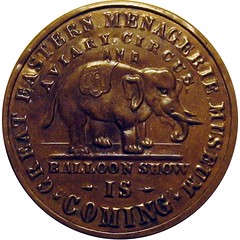
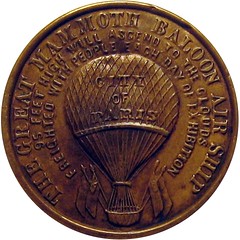
Selma Alabama Shell Card Token. Great Eastern Menagerie Museum Aviary Circus And Balloon Show Is Coming with image of elephant on obverse. The Great Mammoth Balloon Air Ship 95 Feet High Will Ascend To The Clouds Freighted With People Each Day Of Exhibition with image of giant balloon in center labeled City Of Paris
To read the complete lot description, see:
www.ebay.com/itm/Selma-Alabama-Shell-Card-Token-Aviary-Circus-Balloon-Show-Elephant-Balloon-/201233963752
EIGHTEENTH CENTURY LONDON MUSEUM TOKENS

Sir Aston Lever's Holophusicon
MUSEUMS have always been popular places to visit, even in the 18th century and in Leicester Square was one of the more unusual ones, the
Holophusicon, better known as the Leverian Museum. Sir Aston Lever was a passionate collector of fl ora and fauna and coming from a wealthy family,
he was able to indulge his passion, filling his house, Alkrington Hall, with the collection. Although this private museum was open to visitors,
entrance was restricted to acquaintances of Sir Aston as it seems he did not like the common people looking round his house. Another way in which he
discouraged visitors was to refuse entry to those who arrived on foot; one enterprising fellow when refused entry went down a lane and returned
riding a cow.
The cost of keeping and improving the collection was a constant drain on Lever’s resources, so he took his museum to London where he could charge people to view it. Leicester House in Leicester Square was rented and the collection was spread throughout its 16 rooms and corridors. Lever himself travelled with the collection to ensure its safe arrival in London and the museum opened in February 1775. The charge for admission varied over the years, starting at 5s 3d it was eventually reduced to 2s 6d which Lever still hoped was high enough to keep out the common people. Subscribers could pay two guineas for an annual ticket and the copper token with HOLOPHUSICON on the obverse and Sr. A.L (Sir Aston Lever) on the reverse is probably one of these annual tickets.
The Holophusicon became the talk of London and was in its time the largest collection of natural history and miscellany on view. Lever was by now in debt and the entrance money, although substantial, was not sufficient to clear it. He tried to sell the collection as a whole, but no one was interested and his offer to the British Museum was equally unsuccessful. Using his influence Lever managed to obtain an Act of Parliament for a public lottery to dispose of his museum; unfortunately only 8,000 of the proposed 36,000 tickets were sold at £1 each. The winning ticket was held by James Parkinson, a stationer from Blackfriars. Parkinson allowed Lever to remain in Leicester House while he tried to sell the collection; Sir Aston finally left in 1786 and died two years later. Meanwhile, Parkinson having been unsuccessful in selling the collection, moved it to a specially designed building in Blackfriars Road, and although it remained there for some 20 years it did not attract many visitors; eventually it was sold at an auction lasting more than 60 days.
Thomas Middlebrook
 In
1879 Thomas Middlebrook took over the Edinburgh Castle tavern in Mornington Road and opened a museum of military and other relics. Here one could see
an egg of the Great Auk, supposedly the largest egg in the world, the bugle on which William Brittain sounded the charge of the Light Brigade and the
ensign that midshipman Gundy hauled down on the Chesapeake in 1813 after it was defeated by the English frigate Shannon.
In
1879 Thomas Middlebrook took over the Edinburgh Castle tavern in Mornington Road and opened a museum of military and other relics. Here one could see
an egg of the Great Auk, supposedly the largest egg in the world, the bugle on which William Brittain sounded the charge of the Light Brigade and the
ensign that midshipman Gundy hauled down on the Chesapeake in 1813 after it was defeated by the English frigate Shannon.
Middlebrook issued a series of copper tokens to advertise his museum and invited people to visit it free of charge, the tokens may have been used as an entrance ticket. The earliest of the tokens has a bearded bust on the obverse which is most likely Middlebrook himself, the reverse is dated 1879 and has details of the museum and what is on view. The next token has a similar reverse while the obverse has a view of the castle on the mound at Edinburgh; this token is found in brass as well as copper.
A third token was undoubtedly issued to celebrate a Christmas, most likely in the 1880s but unfortunately the token is undated. The final token was clearly made to celebrate the diamond jubilee of Queen Victoria in 1897. Middlebrook died in 1907 and in the following year the museum collection was sold at auction.
For more information or to subscribe to Coin News, see:
http://www.tokenpublishing.com/coins.asp
THE BOOK BAZARRE
BILLIONAIRE BOUGHT WATSON’S GOLD NOBEL
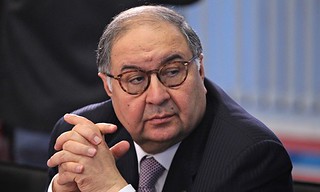 The richest
man in Russia and a major shareholder in Arsenal football club has come forward as the buyer of James Watson’s Nobel medal – declaring that he now
plans to give the piece back.
The richest
man in Russia and a major shareholder in Arsenal football club has come forward as the buyer of James Watson’s Nobel medal – declaring that he now
plans to give the piece back.
Alisher Usmanov, the Russian entrepreneur, paid $4.1m (£2.6m) for the medal at an auction at Christie’s in New York city last week, but said he will return it to Watson, who with Francis Crick and Maurice Wilkins, shared the 1962 Nobel prize in medicine for discovering the double helical structure of DNA.
Usmanov, whose steel, mining and other assets are worth $15bn according to Forbes, said he wanted the medal to remain with its rightful owner and for the money he spent on the item to be donated to scientific research.
"In my opinion, a situation in which an outstanding scientist has to sell a medal recognising his achievements is unacceptable," Usmanov said in a statement.
"James Watson is one of the greatest biologists in the history of mankind and his award for the discovery of DNA structure must belong to him," he added.
Watson became the first living laureate to auction his Nobel medal in a sale that earned far more than the $3m that some experts had predicted. Last year, the family of Francis Crick, who died in 2004, sold his medal for $2.27m.
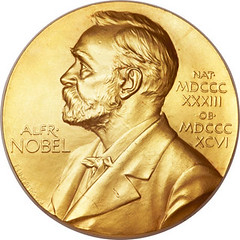 Before
the auction, Watson said he was selling the medal to raise money for the Cold Spring Harbor Laboratory in Long Island, from where he was suspended as
chancellor after he claimed that black people were not as intelligent as whites.
Before
the auction, Watson said he was selling the medal to raise money for the Cold Spring Harbor Laboratory in Long Island, from where he was suspended as
chancellor after he claimed that black people were not as intelligent as whites.
After the unusual intervention, Usmanov said that Watson could now keep the medal but donate the proceeds of the sale to the research institutions that had "nurtured him", including the universities of Cambridge, Chicago and Indiana.
"Dr Watson’s work contributed to cancer research, the illness from which my father died. It is important for me that the money that I spent on this medal will go to supporting scientific research, and the medal will stay with the person who deserved it. I wouldn’t like the medal of the distinguished scientist to be an object on sale," Usmanov’s statement said.
To read the complete article, see:
Billionaire bought
James Watson’s Nobel prize medal in order to return it
(www.theguardian.com/science/2014/dec/09/russian-billionaire-usmanov-james-watson-nobel-prize-return-scientist)
To read the earlier E-Sylum articles, see:
JAMES WATSON'S 1962 GOLD NOBEL PRIZE MEDAL (www.coinbooks.org/esylum_v17n49a23.html)
WATSON'S 1962 NOBEL MEDAL BRINGS $4.75 MILLION
(www.coinbooks.org/esylum_v17n50a13.html)
WAYNE'S NUMISMATIC DIARY: DECEMBER 14, 2014
The months fly by fast. Tuesday night was the holiday dinner meeting of my Northern Virginia numismatic social group, Nummis Nova. I arrived about 6:30 at the Union Street Public House in Alexandria, VA., and headed upstairs to where we had a table. I sat down next to Lenny Goldberg and across from Wayne Herndon and his wife Karin.
Soon we were joined by Heather and Eric Schena, Amelia and Gene Brandenburg, Joanne and Dave Schenkman, Alice and Joe Levine, Fran and Julian Leidman, and Steve Bishop. Illness had felled some of our other regular attendees, but it was still a great turnout.
I brought along a duplicate from my library that I'd sold to Eric Schena. It was a clothbound copy of the 1896 volume of Sound Currency, a publication of the Sound Currency Committee of the Reform Club. It's a great little periodical with articles on money, banking and banknotes, such as:
- Bank Note Issues in Colonial New England
- Massachusetts State Bank Currency
- Rhode Island State Bank Currency
- Connecticut State Bank Currency
- United States Notes, commonly called Greenbacks
- National Bank Notes
- The Crime of 1873
- Canadian Bank-Note Currency
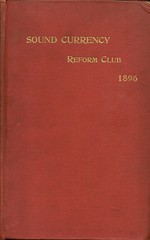
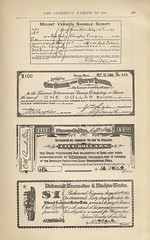
The highlight of the volume for me (and Eric as well) is a February 15, 1895 article by John DeWitt Warner on The Currency Famine of 1893. The twenty-page article describes the preconditions and circumstances of the Panic of 1893 and illustrates some 39 examples of 1893 Clearing House Certificates and other scrip notes from around the U.S., including "Mount Vernon Shingle Script".
Eric writes
That is a perfect "as it happened" account of the Panic and could not be any more pleased to have that in my library.
Christmas Medalets
Dave Schenkman passed around these great Christmas medalets. Thanks for the images!
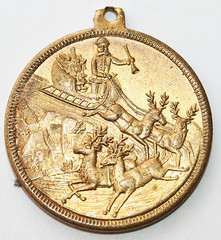
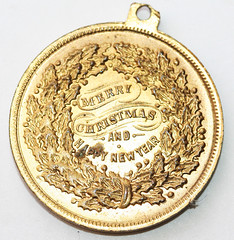

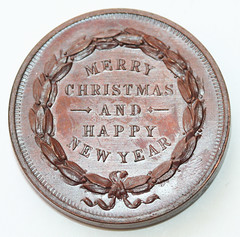
Dave writes:
The copper one is 32mm; the gilt brass one is 27.5mm.
1841 Gold Victoria Presentation Medal
Dave blew my socks off with this amazing Queen Victoria gold medal from 1841. Wow!
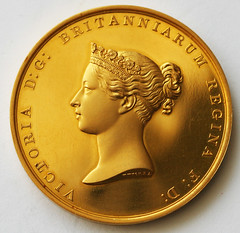

Dave writes:
This 45mm medal is listed in Laurence Brown’s British Historical Medals 1837-1901 as number 1991. According to Brown, they were "used as gifts from the Queen to foreigners who had made special presents to Her Majesty." He estimates about twenty struck in gold.
While corresponding with David Pickup I asked him about this medal, and he sent me a scan of the appropriate page of Brown's book (p55). Thanks! The recipients of twelve of them are known. Several recipients had sent the queen books or artworks. Some of the recipients were in the U.S.:
24 Jul 1851: Mr Cummings of New York 'who sent to the Queen a miniature of Mrs Washington'
23 Apr. 1858: Dr Wynne, of Baltimore, for a Report on the progress of Cholera in the United States in 1849
27 Sept. 1858: 2 gold medals, (large with Reverse No. 3, without loops) 'for two Senior Officers of the American Navy who assisted in laying down the Electric Cable'.
Dave adds:
Brown also mentions that 24 medals were struck in bronze for presentation to senior Foreign Office officials. And, a single medal in silver is known; in the Royal Mint museum. My medal was on a 1961 Seaby list. Joe Levine corresponded with Chris Eimer, and evidently some medals were engraved with the recipient’s name on the edge. Mine is not.
One More Nail in Your Coffin
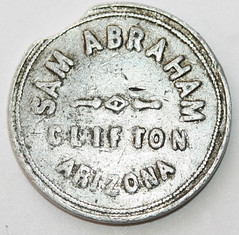
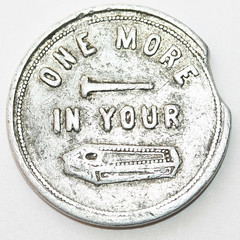
Heather Schena collects exonumia relating to undertakers. Dave writes:
I’ve always liked tokens with rebus inscriptions, and this one is quite rare. I brought it to show Heather because of the coffin.
The conversation was a delight, but unfortunately I couldn't stay. I had to leave at 8 so I could get home to take my boys to their basketball practice. I'm told the rest of the evening was equally delightful. With such a great crowd, how could it not be? I'm already looking forward to January.
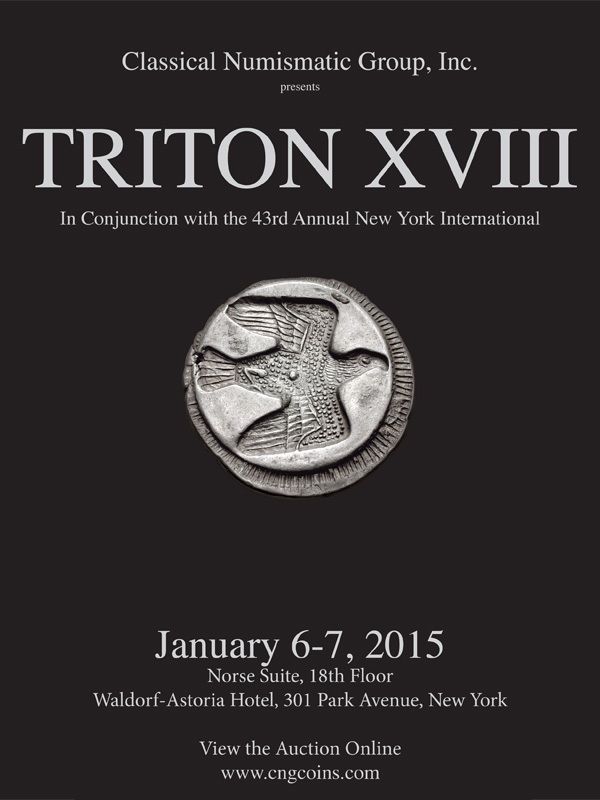
"HERCULES" COINS IN BURNHAM’S CELESTIAL HANDBOOK
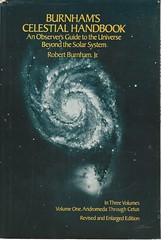 Burnham's
Celestial Handbook: An Observer's Guide to the Universe Beyond the Solar System by Robert Burnham, Jr., New York: Dover Publications (1966,
1978) remains a reliable reference for the backyard astronomer or local club meet-up. "Everyone" in the hobby knows the book. Robert Burnham, Jr.,
compiled this information for himself when he worked at the Lowell Observatory outside Flagstaff, Arizona. He organized his notebook by
constellation. Dover published the work in three volumes. The books were set in a fixed-pitch typewriter font, ragged right. They are paginated
sequentially from 1 to 2138. The work closes with eight indexes. Burnham relied on the Observatory’s own library, but went far beyond that. The
discussion of binary stars, clusters, and other objects in the constellation of Hercules includes images of eleven coins.
Burnham's
Celestial Handbook: An Observer's Guide to the Universe Beyond the Solar System by Robert Burnham, Jr., New York: Dover Publications (1966,
1978) remains a reliable reference for the backyard astronomer or local club meet-up. "Everyone" in the hobby knows the book. Robert Burnham, Jr.,
compiled this information for himself when he worked at the Lowell Observatory outside Flagstaff, Arizona. He organized his notebook by
constellation. Dover published the work in three volumes. The books were set in a fixed-pitch typewriter font, ragged right. They are paginated
sequentially from 1 to 2138. The work closes with eight indexes. Burnham relied on the Observatory’s own library, but went far beyond that. The
discussion of binary stars, clusters, and other objects in the constellation of Hercules includes images of eleven coins.
The coins are in approximately chronological order, beginning with what Burnham calls "a wonderfully archaic style" from Thebes c. 430 BCE. (It corresponds to Sear GCV 2377, though Burnham gives no catalogue numbers.) Also shown are a silver stater of Camarina, Sicily, (similar to SGCV 738). Of course, a Herakles/Zeus of Alexander the Great appears ("a thinly disguised portrait" according to Burnham). A shekel of Tyre, and a tetradrachm of Demetrios of Bactria also are illustrated.
Three coins recognize the Twelve Labors: Herakles versus the Cretan bull on a didrachm from Silenus (SGCV 908); wrestling the Nemean lion (identified on as from the town of Heraclea); and fighting the Stymphalian birds (Stymphalos, Arkadia, SGCV 2739). Then, the hero is shown seated on a stater from Kroton, Bruttium (SGCV 473).
The section closes with two Spanish 8 reales because they depict the Pillars of Hercules. The first was struck at Potosi, 1682. The second, struck in 1740, was recovered only after 1968, coming from the wreck of the Hollandia in the Scilly Islands in 1743.
Astronomy and numismatics share a large debt to their amateur researchers. Until the 20th century, professional appointments in astronomy were limited to a few national observatories in Europe and the Americas. Even in the space age, paying gigs are rare. However, the worldwide amateur community is huge, discovering comets and asteroids, measuring stars, often completing important assignments when the major observatories are clouded over or out of the line of sight of some event.
Of course, money objects are common media for depictions of stars, the moon, and other celestial objects. Marshall Faintich’s monograph Astronomical Symbols on Ancient and Medieval Coins (reviewed for The E-Sylum Volume 13, Number 45, November 7, 2010, Article 4) is a great introduction to this fascinating study. In our time, Romania issued a 2000-lei banknote commemorating the last solar eclipse of the 20th century. The back shows the path of totality over Romania.
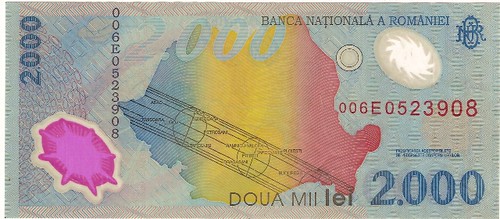
To read the earlier E-Sylum article, see:
BOOK REVIEW: ASTRONOMICAL SYMBOLS ON ANCIENT AND MEDIEVAL COINS
(www.coinbooks.org/esylum_v13n45a04.html)
CHINESE CITY BURNS MONEY FOR POWER
China’s economic growth may be cooling down but the energy sector has plenty of money to burn.
A power plant in Luoyang City, in the country’s central Henan province, is using old banknotes rather than coal as fuel for its furnaces and to provide power for the region. According to reports from the official Xinhua news agency, a tonne of blazing banknotes can help contribute 660 kilowatt hours (kWh) of energy and generates far less pollution than the fossil fuel traditionally used –a bonus in a country notorious for smog in its cities.
The People’s Bank of China (PBOC), the country’s central bank, has approved incinerating the banknotes according to Xinhua, and this is the first time they have been used as fuel. "With Henan’s current unused paper money counted, the company can help generate 1.32 million kWh of electricity annually, which is equal to burning 4,000 tonnes of coal," a PBOC source told Xinhua.
China is not alone in having money to burn. The Bank of England destroys billions of pounds worth of banknotes every year as they become worn out. Each year the Bank receives about 700m tonnes of notes that have been withdrawn from circulation.
To read the complete article, see:
A Chinese
city is burning money for power instead of coal
(www.telegraph.co.uk/finance/newsbysector/energy/11287488/A-Chinese-city-is-burning-money-for-power-instead-of-coal.html)

LORD ASHCROFT PAYS £312,000 FOR LATEST VICTORIA CROSS
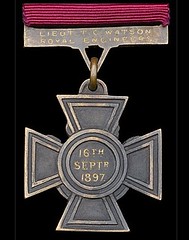 Lord
Ashcroft, the Conservative peer, has added to his renowned collection of Victoria Crosses by paying £312,000 for a medal won by a young British
officer who saved his soldiers from being wiped out by tribesmen.
Lord
Ashcroft, the Conservative peer, has added to his renowned collection of Victoria Crosses by paying £312,000 for a medal won by a young British
officer who saved his soldiers from being wiped out by tribesmen.
Lt Thomas Watson fought on despite being shot three times as he tried to clear a hill village under cover of darkness and his courage was praised of a young Winston Churchill.
Commanders noted the officer had "in all probability saved the whole force from being wiped out" by the Pashtun tribesmen who heavily outnumbered the British during the action on India’s North West Frontier in September 1897.
Lord Ashcroft bought the medal on Friday at auction in London after fierce bidding pushed the price well beyond the expected £180,000, to £260,000. With all the fees added on the overall price paid at auctioneers Dix Noonan and Webb was £312,000. He said: "In my opinion it is one of the finest Victoria Crosses of the Victorian era."
The medal will eventually be displayed alongside the rest of his collection in the Imperial War Museum’s Lord Ashcroft Gallery.
The peer has the world’s largest collection of Britain’s highest battlefield award for gallantry, having bought more than 180 of them in the past 30 years.
To read the complete article, see:
Lord Ashcroft pays
£312,000 for latest Victoria Cross
(www.telegraph.co.uk/news/uknews/defence/11290934/Lord-Ashcroft-pays-312000-for-latest-Victoria-Cross.html)
ARTICLE EXAMINES HIGH PRICES FOR MILITARY MEDALS
 The centenary
of the First World War has reminded us of the extraordinary heroism of those who fight for their country.
The centenary
of the First World War has reminded us of the extraordinary heroism of those who fight for their country.
And while medals earned by wartime heroes may be beyond value to their relatives, the cold fact is that these awards can command huge prices.
Last month, the medals of "Clem" Clements, who won three awards for gallantry during the Second World War, sold for £98,400, more than double the estimate, at Spink, the auction house.
Also sold were the medals won by Spitfire hero RF "Pied Piper" Hamlyn, which realised £90,000 – again, far above their estimate.
With military medals it is the recipient's story and the rarity of the medal that determine the price. The Victoria Cross and Bar awarded to Capt Noel Chavasse for his service in the First World War were sold to Lord Ashworth, the medal collector, for a reported £1.5m in 2009. They are now in the Imperial War Museum. And the posthumous VC awarded to New Zealander Capt Alfred Shout, who was killed at Gallipoli, sold for more than £490,000 in 2006.
Medals from more recent conflicts command big prices too: the sale of Falklands bomb disposal hero John Phillips's Distinguished Service Cross realised £120,000 when sold by specialist auctioneers Dix Noonan Webb in 2011.
Those who sell medals seldom do so lightly, but they should be comforted by the respect the buyers have for them.
Nick Thompson, a medal valuation consultant for auctioneers Richard Winterton, said: "I am always saddened that any medals are on sale rather than being where they were intended: with the recipient or family. However, almost all collectors I know see themselves as the current custodian and treat the medal with the respect it deserves."
Oliver Pepys of Spink added: "On the whole, people don't buy medals for investment reasons. It is primarily a hobby, but one where you should hopefully see a return."
Medals can be divided into those awarded for gallantry and those for taking part in a campaign. The first campaign medal was awarded to many of those who served under Oliver Cromwell in the Battle of Dunbar in 1650. But the first campaign medal awarded to every participant was the Waterloo Medal of 1815.
For collectors, "top of the tree is the Victoria Cross (whose inscription is "For valour") - they are the holy grail of medal collecting", said Mr Millensted. There are just 1,357 VCs in circulation. Mr Pepys added: "VCs were first awarded in 1856 and backdated to the Crimean war of 1854, so they have been around for 150 odd years.
"But the nature of warfare has changed and the opportunity for awarding VCs is far less than it was. In the Great War you could be awarded a VC for pulling a wounded colleague back from no-man's-land but nowadays warfare is more scientific. Far fewer VCs are awarded and they are therefore more scarce and potentially more valuable."
Prices of VCs are rising. Dan Wade of Paul Fraser Collectibles said: "A Victoria Cross could achieve around £10,000 in 1990. The record price for a single VC now stands at £678,662 (awarded to Australian war hero Ted Kenna), with prices routinely surpassing £200,000 for examples from the First World War."
To read the complete article, see:
The war medals that
have soared in value (www.telegraph.co.uk/finance/personalfinance/investing/11280125/The-war-medals-that-have-soared-in-value.html)
ADAMS COLLECTION OF SPANISH COLONIAL PROCLAMATION MEDALS
THE JOHN W. ADAMS COLLECTION OF SPANISH COLONIAL PROCLAMATION MEDALS WILL BE OFFERED AT THE STACK’S BOWERS GALLERIES OFFICIAL AUCTION OF THE NYINC
Stack’s Bowers Galleries is privileged to present to the numismatic community an incredible cabinet of Spanish Colonial Proclamation medals: The John W. Adams Collection. Over the last several decades, Mr. Adams carefully assembled this collection acquiring many of the medals from Richard Ponterio. Stack’s Bowers Galleries has a long association with Mr. Adams, having sold his famous collection of 1794 large cents in 1982 and his European Indian Peace Medal Collection in January 2009.
John W. Adams has been collecting for nearly 60 years. Like many serious numismatists, he began collecting Lincoln cents from circulation and filling in old coin folders. As he became more advanced, he built a collection of Proof Indian Head cents, as well as an extensive collection of 1794 large cent varieties that the firm (Bowers and Merena) sold in 1984. About this time he changed his focus to historical medals. Over the years John Adams built a definitive collections of European Indian Peace medals, which was sold at the firm’s (Stack’s) 2009 January Americana Sale. As he continues to collect and research these intriguing areas of numismatics, Stack’s Bowers Galleries has again been chosen to sell this important cabinet of Spanish Colonial Proclamation medals, one of the most complete and advanced collections offered in recent memory.
Proclamation medals are highly historic and important, and due to their overall rarity, seldom offered in the marketplace. Over the years, Stack’s Bowers Galleries has been privileged to offer more of these medals than any other numismatic auction firm. Generally speaking Proclamation medals were produced in various cities (or bishopric, church, college, etc.) to display loyalty and allegiance to the new monarch. In the Spanish Empire, these were produced in various colonial cities, and were issued during the festivals and ceremonies honoring the new king. These were often lavish events, and in Buenos Aires, the proclamation ceremonies for Ferdinand VI lasted for 21 days and constituted the largest festival held there during the colonial era. Despite generous production figures, the number of Proclamation medals that survive to the current day is quite small.
Generally they were made in silver, although there were examples produced in gold and bronze. Since these medals were thrown to the crowds during these proclamation ceremonies, they were more likely to be spent or melted than saved. As a general rule the earlier medals (Philip V-Charles III) are much rarer than the later medals of Charles IV and Ferdinand VII. Many of the early medals are found holed to be worn as a medallion by the upper class. If a new king was proclaimed, existing medals were often replaced with those of the current reigning monarch. Thus many of the earlier medals were melted down and the metal repurposed. A large number of the medals from this early period are exceedingly rare, ranging from unique to only a few examples known.
The John W. Adams Collection of Spanish Colonial Proclamation medals offers collectors a rare and in some cases unique opportunity to acquire highly significant and seldom offered historical medals. Mr. Adams focused his collection on medals pertaining to events that took place in the New World prior to the independence of the United States in 1776, primarily on the reigns of Philip V to Charles III (1701-61), with a few later date medals also included. "The John W. Adams Collection is by far the most advanced cabinet of these early medals to ever be sold at public auction," said Richard Ponterio, executive vice president of Stack’s Bowers Galleries. "It features many rarities, along with several items that are believed to be unique.
During the period Mr. Adams was collecting, several major, old time collections came to market, allowing him to acquire many incredibly rare pieces that had never been offered before." A good number of the medals in this collection were sold in the 1990s in a series of sales including the Ponterio & Associates Sale #87 in April 1997. Additional pieces were purchased at the Ponterio & Associates Sale # 109 in October 2000 when the firm offered The Porraz Collection. Shortly after The Porraz Collection was sold, The Lavin Collection was dispersed, offering further opportunity for Mr. Adams to add rarities to his cabinet. "This period of time was an embarrassment of riches for this incredibly rare series," said Richard Ponterio. "The number of Proclamation medals made available in this short period resulted from several major collections appearing on the market, but is not indicative of the rarity or availability of these medals in the general marketplace." Senior numismatist and consignment director of world and ancient coins Kent Ponterio added: "These circumstances allowed The Adams Collection to become the apex of all early proclamation collections. Assembling a collection of comparable magnitude in this day and age is highly improbable."
"It has been a joy and an honor to view and catalog this many early Proclamation medals in one collection. I commend Mr. Adams for assembling such an important collection, and hope that the presentation of this cabinet allows today’s numismatists to appreciate the hard work and effort required for such an accomplishment," Richard Ponterio concluded.
Highlights of this important cabinet include:
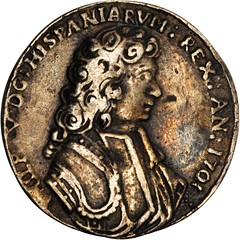

Lot 1002. MEXICO. Veracruz. Cast Silver Proclamation Medal, 1701. Philip V (1701-46). VERY FINE.
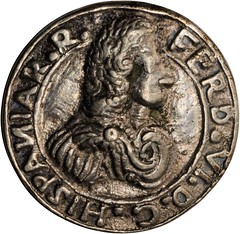

Lot 1011. MEXICO. Veracruz. Cast Silver Proclamation Medal, 1747. Ferdinand VI (1746-59). Choice Very Fine.
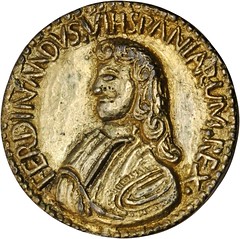
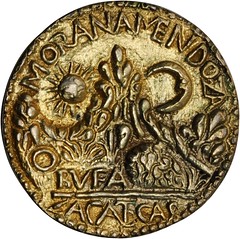
Lot 1013. MEXICO. Zacatecas. Gilt Cast and Chased Silver Proclamation Medal, ND. Ferdinand VI (1746-59). CHOICE EXTREMELY FINE.
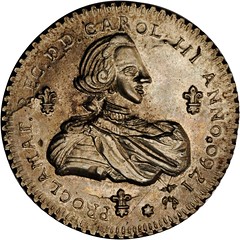

Lot 1032. MEXICO. Valladolid de Michoacan. Silver Proclamation Medal, 1760. Charles III (1759-88). CHOICE EXTREMELY FINE.
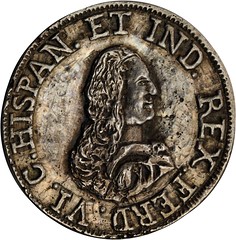

Lot 1039. ARGENTINA. Buenos Aires. Cast Silver Proclamation Medal, 1747. Ferdinand VI (1746-59). Extremely Fine.
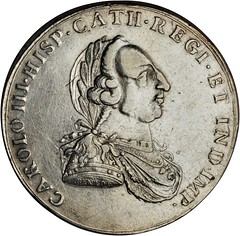
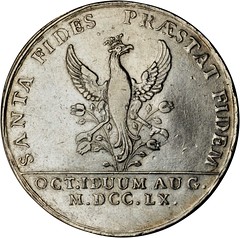
Lot 1044. COLOMBIA. Santa Fe de Bogota. Silver Proclamation Medal, 1760. Charles III (1759-88). Very Fine.
In addition to his acclaimed collections, John Adams has authored dozens of articles and published six numismatic reference books: United States Numismatic Literature, Volume I; United States Numismatic Literature, Volume II; The Indian Peace Medals of George III; The Medals Concerning John Law and the Mississippi System; Comitia Americana and Related Medals; and Medallic Portraits of Admiral Vernon, Medals Sometimes Lie.
This extensive corpus led to the American Numismatic Society bestowing upon Mr. Adams its highest award, the Archer M. Huntington Medal for lifetime achievement in numismatic scholarship. The award ceremony and celebratory dinner took place in Boston on April 26, 2014, and Mr. Adams noted: "The hobby is only partially about the breadth of a collection and the quality of the coins. Rather, the unexpected but greatly-to-be-desired outcome of collecting is the sharing of knowledge and experience with persons of like mind. It is these lasting bonds of friendship that are the true treasures of the hobby." We cannot agree more.
The John W. Adams Collection will be sold Saturday, January 10, at the beginning of Session B of the Official Auction of the Stack’s Bowers New York International Numismatic Convention. Other important collections being offered are The Stanley Aberdeen Collection of Swedish Plate Money, The Richard Aghababian Collection of Ancient Coins, The Ray Czahor Collection of Philippine Countermark Coins, selections from The Demarete Collection, The Rockaway Collection, and other properties.
For more information on this sale, or to request a catalog, contact a Stack’s Bowers Galleries associate at 800.458.4646 (West Coast), 800.566.2580 (East Coast), or email info@stacksbowers.com.
MARK LOVMO'S ARTICLES ON SOUTH KOREAN NUMISMATICS
Regarding Dick Johnson's article on U.S. Mint engraver Engelhardus von Hebel, Mark Lovmo writes:
Thanks for adding Dick Johnson's answer to your e-newsletter about my inquiry at Coin Talk.
At the time of my inquiry, I was spending a considerable amount of time researching information for an article that I eventually published in October this year about South Korea's first circulation coins, the "Hwan"-denominated coins.
The initials on the coin is obviously Engelhardus von Hebel, as that could be the only "EvH" connected to this coin. I'd like to contact Dick about his knowledge of Mr. Engelhardus' work on the 100 Hwan coin so that I can update my "Hwan Coins" article. Most importantly, I'd like to thank him!
I have written five open-source, public domain articles that I think readers interested in South Korean numismatics may find interesting.
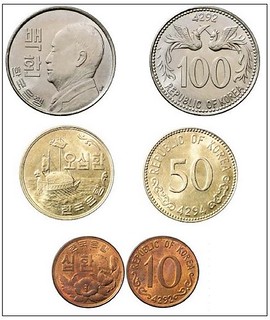 To
read the complete articles, see:
To
read the complete articles, see:
The Hwan Coins of South Korea in the Era of National Transformation
(http://dokdo-research.com/hwancoins.html)
The South Korean Pattern Coins of 1965-1966
(dokdo-research.com/koreanpatterncoins.html)
The Contemporary "Won" Coins of the Republic of Korea (1966 - Present)
(http://dokdo-research.com/koreancoins.html)
The "Five Millennia History of Korea" Gold and Silver Commemorative Coins of 1970
(http://dokdo-research.com/fivemillenia.html)
The Republic of Korea "Fifth Republic" Commemorative Coins (1981)
(http://dokdo-research.com/fifthrepubliccommems.html)
Coin Shops in Seoul, Korea (http://dokdo-research.com/coinshops.html)
To read the earlier E-Sylum article, see:
U.S. MINT ENGRAVER ENGELHARDUS VON HEBEL (www.coinbooks.org/esylum_v17n49a17.html)

'STUART LITTLE' PAINTING BRINGS $285,700
 An avant-garde painting lost for nine decades until a Hungarian researcher spotted it being used
as a prop in the Hollywood film "Stuart Little" was sold for over 200,000 euros Saturday at an auction in Budapest.
An avant-garde painting lost for nine decades until a Hungarian researcher spotted it being used
as a prop in the Hollywood film "Stuart Little" was sold for over 200,000 euros Saturday at an auction in Budapest.
The painting "Sleeping Lady with Black Vase", by Robert Bereny (1887-1953), fetched a price of 229,500 euros ($285,700), more than doubling its reserve price of around 110,000 euros.
Staff at the Virag Judit auction house told AFP that the buyer was an unnamed private Hungarian collector, and that the sale price exceeded expectations.
"I always knew it was a masterpiece, now it seems the market agrees," said Gergely Barki, 43, the Hungarian National Gallery researcher who noticed the painting in the 1999 kids' movie about a mouse as he watched TV with his daughter Lola on Christmas Eve six years ago.
The work disappeared in the late-1920s but Barki recognised it immediately even though he had only ever seen a faded black-and-white photo dating from a 1928 exhibition catalogue archived in the National Gallery.
To read the complete article, see:
Missing
artwork rediscovered in "Stuart Little" sells for over 200,000 euros at auction
(http://artdaily.com/news/75029/Missing-artwork-rediscovered-in--Stuart-Little--sells-for-over-200-000-euros-at-auction#.VI2n3isVhYE)
To read the earlier E-Sylum article, see:
HOW STUART LITTLE RESCUED A LOST PAINTING (www.coinbooks.org/esylum_v17n49a37.html)
HANUKKAH CHOCOLATE COINS
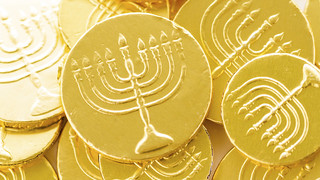 Hanukkah, the Jewish festival of lights, starts on Tuesday night. But the flickering candles won't be the only things shining on the table. Many
families celebrate with gelt, chocolate coins covered in gold and silver foil. But while this treat is beloved, it's not all that delicious.
Hanukkah, the Jewish festival of lights, starts on Tuesday night. But the flickering candles won't be the only things shining on the table. Many
families celebrate with gelt, chocolate coins covered in gold and silver foil. But while this treat is beloved, it's not all that delicious.
"It snaps. It's not soft and buttery — it's waxy. This is chocolate you have to chew," jokes Ariel Cohn, who runs Tree of Life, a Jewish pre-school in Portland, Ore.
Although you can now buy upscale Jewish gelt — from fair trade certified to chocolates shaped like ancient Judean coins — Cohn, like many Jews, still has a sentimental attachment to the waxy coins. Because, well, it's Hanukkah.
"It's what human life is made of," Cohn laughs. "Holidays and gatherings where you see your family and your friends. And you can make anything a part of tradition, really."
But it turns out this particular part of tradition used to look a lot different. Gina Glasman, who teaches Judaic Studies at Binghamton University, says that in the shtetls of Eastern Europe, you do find something that is called Hanukkah gelt. But it has nothing to do with children, and nothing to do with chocolate. Instead, this gelt is basically an end-of-the-year tip for itinerant workers.
"A butcher for kosher meat, and a teacher for Jewish studies," lists Glasman. "And you'd even have a guy employed to bang on people's doors to wake them up for prayers. Hanukkah was a time you paid these men a little bit extra."
Glasman notes there was also a tradition of minting coins for special occasions — but not for Hanukkah. These, instead, were for charitable giving, or holidays like Purim. And if you were to give any sort of gift, it was generally for the holiday of Purim. But as families moved from the community-centered shtetl to towns and cities, these money rituals of the self-sustaining communities began to change — and the practice of Hanukkah began to change as well.
"By the end of the 19th century," Glasman notes, "you see, mysteriously, the custom switch from giving tips to these guys to giving a little gift to your children."
And when Jews began to emigrate, it changed even more — because of Christmas. Jonathan Sarna, who teaches American Jewish history at Brandeis University, says that as Christmas is magnified in the American setting, becoming a national holiday, Hanukkah too becomes magnified. It takes on new importance, and the focus shifts to gift-giving and children. But even so, it still maintains echoes of the past.
"We've morphed that gelt into chocolate coins, as a kind of cultural memory," Sarna notes.
To read the complete article, see:
Hanukkah History: Those
Chocolate Coins Were Once Real Tips
(www.npr.org/blogs/thesalt/2014/12/12/370368642/hanukkah-history-those-chocolate-coins-were-once-real-tips)
COINS AT CHRISTMAS - A COIN COLLECTOR’S CHRISTMAS
Coins at Christmas - A Coin Collector’s Christmas
By David R Pickup
We will start not at the beginning of Christmas but at another beginning. Less important than the nativity, but of great importance to collectors. A few days before Christmas in 1836, on 22nd December, a number of "friends of numismatic science" met in London to set up the Numismatic Society. Their purpose was to "exhibit rare and curious specimens of numismatic art of all ages and countries" as well as read papers on numismatic subjects. I imagine they liked to chat about the "good old days" as well as coins collectors sometimes do.
Membership cost a guinea and a council of seven men were appointed which included William Wyon and Edward Hawkins. John Yonge Akerman and Isaac Cullimore were the first secretaries. Akerman started the society’s journal in the same year. Hawkins was keeper of antiquities at the British Museum and wrote the book called Medallic Illustrations. Akerman was the author of many popular and more specialised books on coins. This was the first meeting of what became the Royal Numismatic Society and the first society devoted to numismatics anywhere.
 We associate Christmas with Charles Dickens. His novel, A Christmas Carol, was written a few years later in 1843. At the time Dickens was
writing his now world famous story he could have consulted an ever-burgeoning number of popular histories of Christmas such as TK Hervey’s Book of
Christmas (1836), and his A History of the Christmas Festival, the New Year and their Peculiar Customs (1843) and Thomas Wright’s
Specimens of Old Carols (1841). Charles Dickens was featured on a well designed two pound coin in 2012.
We associate Christmas with Charles Dickens. His novel, A Christmas Carol, was written a few years later in 1843. At the time Dickens was
writing his now world famous story he could have consulted an ever-burgeoning number of popular histories of Christmas such as TK Hervey’s Book of
Christmas (1836), and his A History of the Christmas Festival, the New Year and their Peculiar Customs (1843) and Thomas Wright’s
Specimens of Old Carols (1841). Charles Dickens was featured on a well designed two pound coin in 2012.
Dickens is said to have invented our modern idea of Christmas with its snow, frost and cold. The 1830s were amongst the coldest on record. Snow lasted well into March, with 8 or 9 feet of snow being reported in parts of the country. This continued for a number of winters. On Christmas Day 1836, the roads were impassable with snow lying five to fifteen deep in many places, and drifts of over twenty feet. Let us leave the "friends of numismatics" to the snow and cold and think about other Christmas coins.
 In
recent years a number of mints have issued Christmas coins. The Isle of Man has issued a Christmas 50 pence piece nearly every year since 1980.
Gibraltar has also issued Christmas-themed 50-cent coins most years since 1990. A country whose Christmas coins stand out for excellence of design is
Latvia. For over 11 years the Bank of Latvia issued special 1-lats circulation coins. The standard of artistic design is very high on all their
coins. The coin with Christmas bells was designed by artist Holgers Elers and modelled by sculptor Laura Medne and struck at the German mint
Staatliche Münze Baden-Württemberg. The total circulation of the coin is one million a comparatively low mintage. I know it sounds a lot but a
million in coin terms is not many. I have just noticed the lion on the left seems to be smoking a pipe!
In
recent years a number of mints have issued Christmas coins. The Isle of Man has issued a Christmas 50 pence piece nearly every year since 1980.
Gibraltar has also issued Christmas-themed 50-cent coins most years since 1990. A country whose Christmas coins stand out for excellence of design is
Latvia. For over 11 years the Bank of Latvia issued special 1-lats circulation coins. The standard of artistic design is very high on all their
coins. The coin with Christmas bells was designed by artist Holgers Elers and modelled by sculptor Laura Medne and struck at the German mint
Staatliche Münze Baden-Württemberg. The total circulation of the coin is one million a comparatively low mintage. I know it sounds a lot but a
million in coin terms is not many. I have just noticed the lion on the left seems to be smoking a pipe!
Christmas is a time for presents of course. Chocolate coins are traditionally given to children as both a Christian and secular tradition at Christmas time and Saint Nicholas Day and in Jewish tradition during Hanukkah. Adult coin collectors are allowed chocolate coins as well in fact it is a good way of combining an interest in numismatics with food. They tend to study the foil wrapper closely to look for mint errors, brockages, and rare dates before eating them. In 2011 The British Daily Mail reported that shops were stopping selling Euro chocolate coins and going back to Sterling chocolate coins. Another tradition which I can remember, so it is later than the Middle Ages, is putting silver coins in Christmas puddings. You had to be careful not to break a tooth when you bit into the pudding. Perhaps it was a way of getting children to eat slowly. Good luck with that!
Not many numismatists seem to get numismatic presents even at this time of year. Why not buy yourself something as a treat? However you are celebrating have a brilliant Christmas and an uncirculated New Year.

FEATURED WEB PAGE: U.S. MINT SPECIAL REPORT
This week's Featured Web Page holds the U.S. Mint's Special Reports. The most recent of these documents in the 2014 Biennial Report to Congress, released this month.The United States Mint released its 2014 Biennial Report to Congress in December 2014 on the research and development (R&D) of alternative metals for the nation’s circulating coins. This report is the second released under the Coin Modernization, Oversight, and Continuity Act of 2010, Public Law 111-302, which authorizes the Secretary of the Treasury to conduct R&D on alternative metallic materials for all circulating coins, with the goal of reducing production costs. The Act also requires the Secretary to provide a biennial report to Congress on the status of coin production costs and analysis of alternative content.

www.usmint.gov/about_the_mint/?action=specialreports
